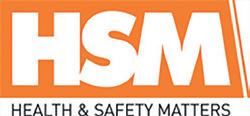Business

















Having provided an extensive independent investigative service for all industry and property sectors, we are sharing our knowledge aimed at reducing the instances of damp and mould with better decision making and proven cost-savings – when you need it!
An independent support Framework will endorse your drive for change and uphold the requirement for immediate proactive guidance
Our expert services include...



Ventilation Compliance
Retrofit & Net Zero Knowledge and and Guidance Impact Assessments

Structural Air Leakage Testing IoT Monitoring and SMART Knowledge alongside Whole Ventilation Rate Alerts and Guidance

Assessing & Certifying existing Bespoke CPD Training for Optimum Structural Health conditions performance and occupant Guidance

A Property Health APP will deliver 24/7 access for damp, condensation and mould issues - with a difference.
Just type in the issue and receive likely reasons alongside recognisable guidance measures for either immediate resolution.
Building Occupants
Solved or, send images to owner Landlords Owners
Solved or, send data to













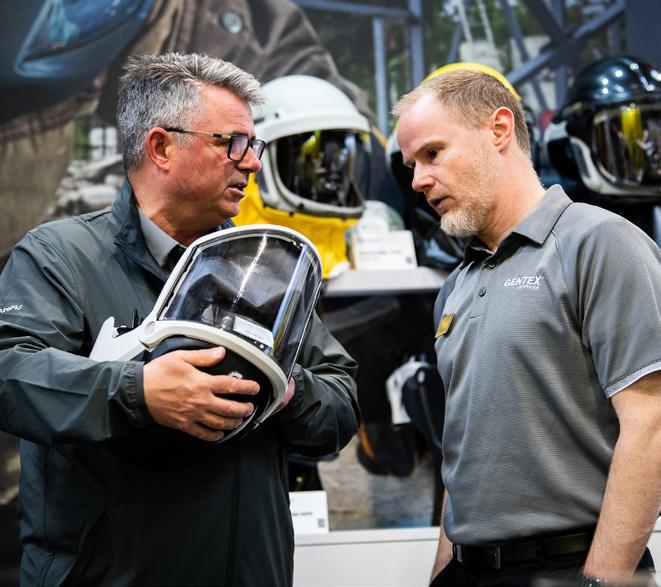







The Department of Education (DfE) has announced it will no longer provide funding for Inspiring Governance, a governor and trustee recruitment service.
The National Governance Association (NGA) has released an open letter to Secretary of State Gillian Keegan calling the choice “nothing short of a disgrace.”
The scheme connects volunteers who are interested in serving as school governors with schools in England.
NGA said Inspiring Governance has helped recruit 8,000 school governors and trustees since it launched with Department for Education funding back in 2016.
However, they also found in a 2022 survey that two-thirds of school or trust governing boards had at least one vacancy as the number of empty posts hit a six-year high.
Emma Knights and Emma Balchin, co-chief Executives at NGA, said in their letter that almost a quarter of a million citizens in England volunteer to govern state schools and academy trusts.
The letter added that the DfE is “no longer supporting in any way this enormous band of selfless people governing our schools and trusts.”
The letter said: “NGA will of course continue to support governing boards, but the fact that your Government seems willing to overlook their contribution is nothing short of a disgrace.”
The funding will end in September.



The Institute for Fiscal Studies (IFS) has said that policymakers in Wales should be doing more to address the underlying reasons why the country performed weakly in the latest PISA standings.
The IFS found that pupils in Wales were only performing as well as disadvantaged children in England.
The organisation found that the results in Wales declined by about 20 per cent of a standard deviation which is more than other UK nations. The results were well below the average across OECD countries.
Laura Doel, national secretary at the National Association of Head Teachers Cymru, said that Welsh schools are “working hard to deliver for their pupils, but this dedication hasn’t been matched by the investment needed, especially on the back of the pandemic and cost of living crisis.”
She said: “School leaders are facing impossible challenges in making budgets add up, with some having to make teachers and teaching assistants redundant when they actually want to recruit more staff to help those pupils with the greatest needs.”
Doel added that the most positive action now would be to pause any “unnecessary reforms like changes to the school day, and a concerted effort to increase support for schools so they can ensure all children get the education they deserve.”
Wales’ lower attainment cannot be explained by higher levels of poverty, according to the IFS, as pupils in areas of England with higher ...

BUILT-IN
Our panels’ design flexibility enables us to construct a wide range of energy efficient buildings including school or college classrooms, student accommodation modules, houses & bungalows. We have a selection of standard designs but can also tailor the build to your exact requirements.

Made in the UK
Fire tested for 3 hours
Unique metal subframe to help protect from flooding
Floors are fully insulated as well as the walls
Excellent acoustic sound reduction
Low air permeability
Rapid construction in any weather
Please call us to find out more about our unique building system


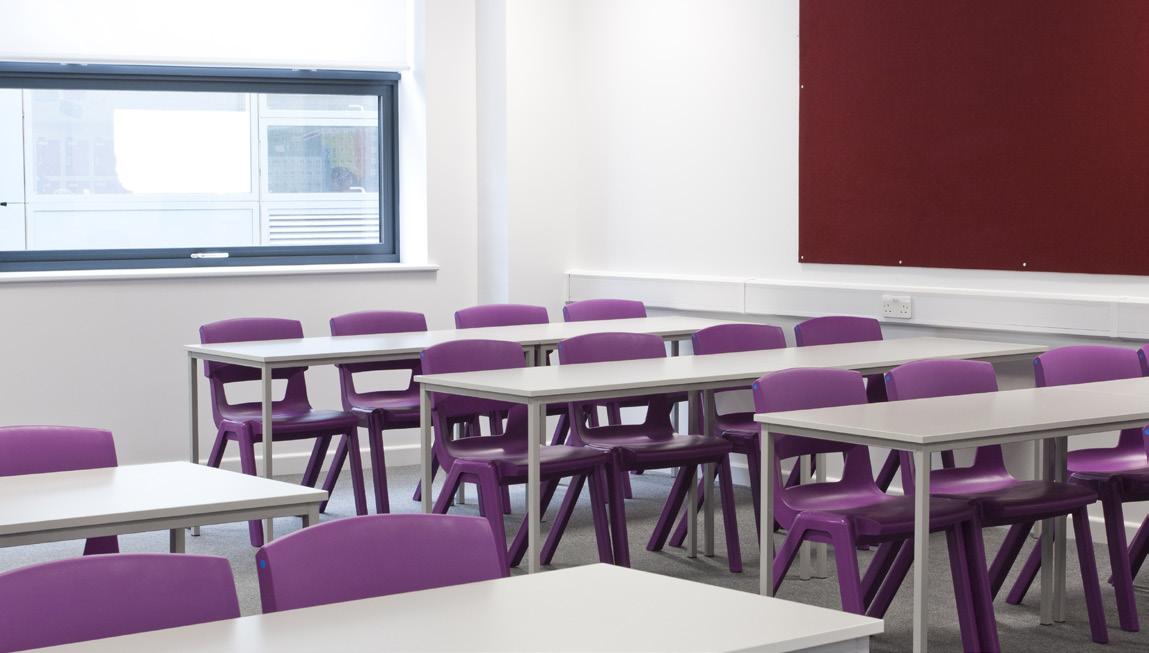

Research from the Archives of Disease in Childhood has found that every new school in England is being built in an area with unsafe levels of air pollution.
Air pollution can cause damage to children’s health by increasing respiratory tract infection rates, asthma exacerbations, allergies and childhood cancers.
The research found that almost 90 per cent of planned school builds exceed three World Health Organisation (WHO) targets on major air pollutants.
The study, led by Evelina London children’s hospital and King’s College London (KCL), called for air quality assessment to be mandatory at the proposal and planning stage of any new school building, and for national guidance and legislation to be updated.
The authors of the report said: “Children deserve protection from avoidable harm while at school.”
They identified more than 180 new schools to be built between 2017 and 2025 in England, and sites for 147 of these schools have been acquired. They assessed air quality at those sites against the WHO air quality targets for PM2.5, PM10 and nitrous oxide, as well as against pollution levels across the UK.
Average readings of PM2.5 across all the sites were more than double those recommended by the WHO.
Large cities such as London, Birmingham, Manchester and Leeds had the highest pollutant levels. However, Liverpool, Bristol and Newcastle recorded lower levels.



Teacher recruitment is still “far below target,” the annual labour market report from the National Foundation for Education Research (NFER) has found.
Despite the Department for Education saying workload reduction is a policy priority, NFER’s reported that rising teacher working hours mean the government may face a challenge in meeting its workload reduction target.
Teachers continue to work longer hours than similar graduates in other jobs during a typical working week.
According to NFER’s research, teachers now say pupil behaviour is driving higher workload and that behaviour management and pastoral care should be key priority areas for workload reduction. More support from outside agencies for specific pupil needs such as special educational needs and disability (SEND) support, mental health and safeguarding are seen by teachers as key to further workload reduction.
In terms of recruitment, the report found that while teacher recruitment is on track to be better this year than last year due to bursary increases and new initiatives to attract international applicants, it is still likely to be far below target.
It predicted secondary recruitment will improve, but still miss its target by about 40 per cent, with 10 out of 17 secondary subjects likely to have shortfalls. Last year, the target was missed by 50 per cent.
Jack Worth, school workforce lead at the NFER and co-author of the report said that teacher ...



Challenging workloads remain big issue for wellbeing
Tes’ Wellbeing Report this year has found that teacher confidence is up but workloads are still causing concerns.
Challenging workloads remain one of the biggest issues confronting educators, and 74 per cent of teachers reported they’ve contemplated leaving the profession in the last year.
As well as this, 78 per cent of school leaders said the same, citing issues with the education system more broadly.
Despite these findings, over 75 per cent of respondents feel confident in their roles as educators and in their ability to educate young people.
Also, over 60 per cent of respondents believe their workload is not manageable, rising to 78 per cent of SENCOs.
Rod Williams, CEO of Tes, said: “Though some existing challenges remain, there are real signs for optimism as leaders listen to their teachers, with many taking advantage of opportunities to change how they do things.
“It’s especially great to see an increase in staff being proud to work in their schools, and a big jump in professional positivity. The sense of community is compelling as teachers and leaders continue to do their best for their students.”
The survey also shone a light on the increase in tools and technology being used in schools.
For example, over a third of teachers said their schools are implementinf time saving behaviour management software or practices...



The Education Policy Institute has released a report, looking at the relationship between the number of suspensions or temporary removals in secondary school and outcomes for pupils in England.
The report found that pupils with even one suspension are, on average, not achieving a standard pass in GCSE English and maths.
Pupils with multiple suspensions have poorer education outcomes. Suspended pupils are, on average, approximately 12 months behind their not-suspended peers and are not achieving a standard pass in GCSE English and maths. This association persists after controlling for a wide range of student and school characteristics.
The proportion of pupils identified with special education needs or disabilities (SEND) increases in line with the number of suspensions. Pupils suspended ten times were almost three times as likely to be identified with SEND as pupils who were suspended once. Of all SEND types, social, emotional, or mental health needs (SEMH) were the most common amongst suspended pupils.
Multiple suspensions are a risk factor for permanent exclusion. Pupils suspended ten times were 15 times as likely to be permanently excluded compared to pupils who were suspended once.
By the time they sit their GCSEs, pupils with multiple suspensions are less likely to be in a mainstream school and more likely to be in alternative provision (AP). Pupils suspended ten times or more were almost 15 times as likely to finish secondary school in alternative provision compared with pupils who were suspended ...

Our Lollipop toilet cubicles deliver fun and safety in equal measure.
Lollipop cubicles feature 2 door height options, with a unique pedestal design for extra rigidity, all in a choice of on-trend finishes. Specially designed anti-finger trap hinges and easy to operate emergency release indicator bolts give added peace of mind for supervising adults. What’s more, you can complete the look with matching vanity units with shaped under panels. Scan
Find out more about our education ranges.
01474 353333
www.venesta.co.uk
marketing@venesta.co.uk
CDMQA

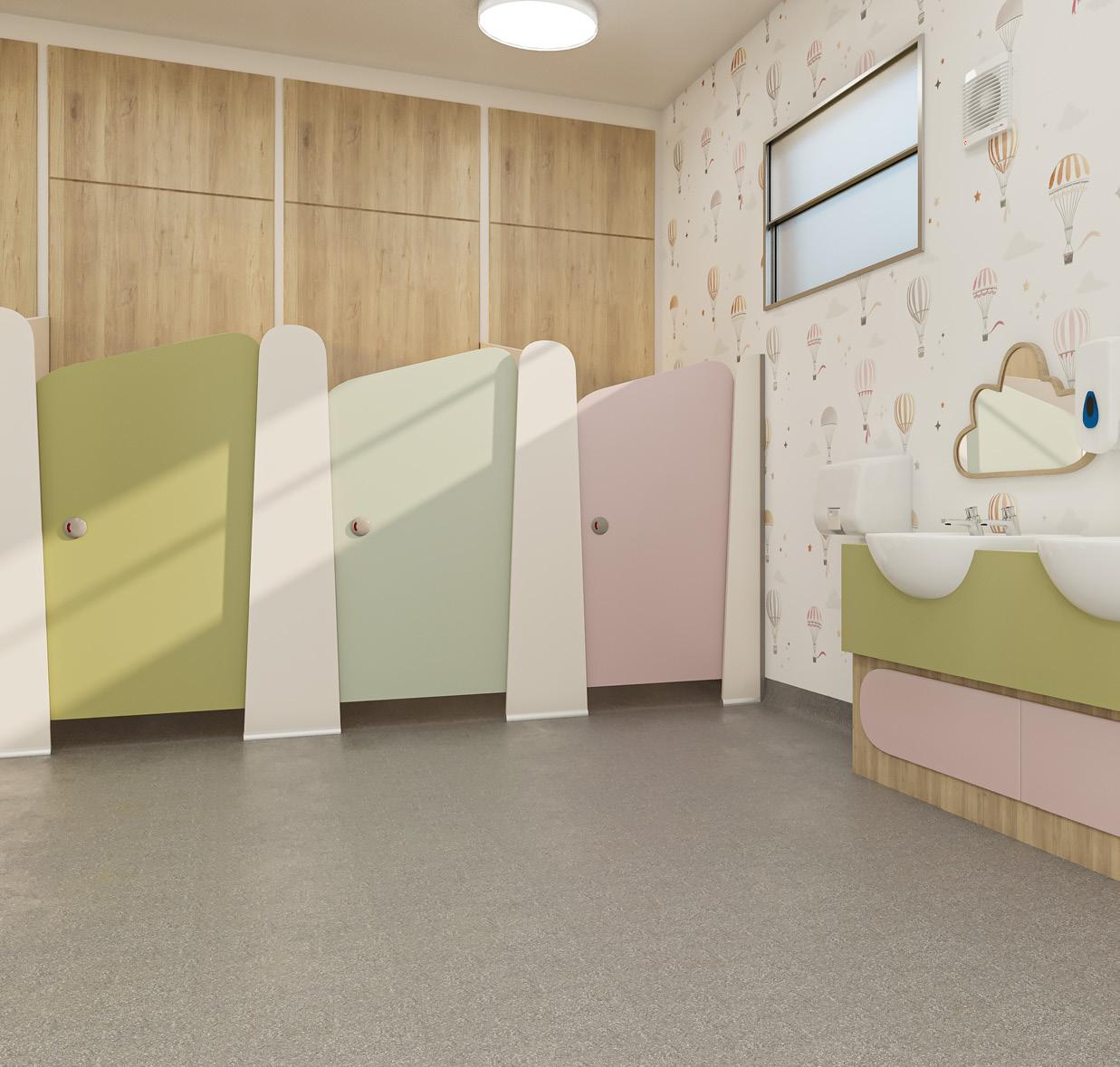

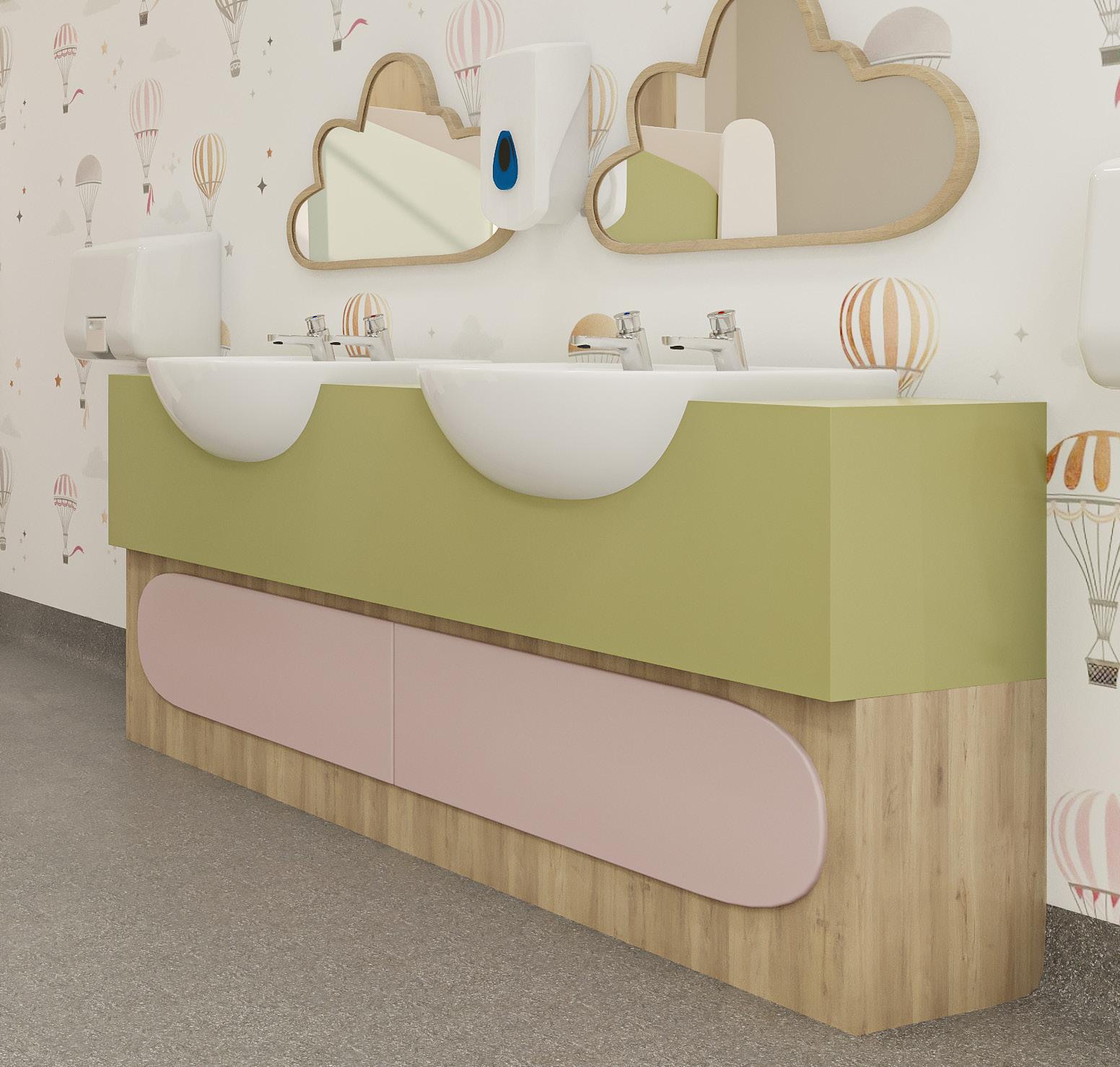

More top news stories from
A letter from charities and local councils has been sent to Schools Minister, Damian Hinds, calling for the government to take action to ensure all children who are entitled to Free School Meals (FSM) are able to receive them.
Currently up to 250,000 children living in some of the most deprived households are missing out on their statutory right to a daily hot nutritious free school meal, with reasons including administrative barriers and language issues.
The letter is co-ordinated by the School Food Review, Bremner&Co and The Food Foundation and signed by 130 representative from charities, councils and academia including the NEU, CPAG and Feeding Britain.
Local authorities using an opt-out rather than an opt-in system to receive FSM report opt-out rates as low as under one per cent. This compares to the Department for Education’s own figures showing 11 per cent of pupils entitled to FSM are not registered to receive them under its scheme. The charities and councils cite complex administration, language or literacy issues and fear of stigma as some of the reasons for this.
Pupil premium funding is given to schools in England for each primary pupil (£1,455 per year) and secondary pupil (£1,035 per year) who have been eligible for FSM at any point in the last six years. This means schools are missing out on this extra funding if eligible pupils are not signed up to FSM.
Research from FixOurFood has pooled data from five local authorities in England which implemented FSM auto-enrolment in October 2023. Results suggested that over 2,500 additional children had been registered to receive free school meals as a result of auto-enrolment...


Report links poverty levels and absences: READ MORE
Girls’ learning impacted by pandemic, report finds: READ MORE
Mental health support wait time deemed ‘shocking’: READ MORE
Higher BTEC qualifications in Esports launched: READ MORE
Ofsted promises to do more following ESC inquiry: READ MORE
A new paper from the University of Glasgow, which looks at how Scotland’s education system can make a real and long-lasting difference in schools, has said that schools and teachers should be at the centre of education reform.
In the paper, Professors Chris Chapman and Graham Donaldson argue that Scotland needs to simplify its approach, giving greater clarity about how we educate our children and young people in an increasingly complex world.
Professor Chapman said: “These are challenging times for Scottish education, not least because of the reform agenda and its implications for our children and young people. As academics working in issues of educational change, improvement and innovation across the globe, combined with a strong commitment to improving education, we are convinced that there is an urgent need for radical thinking about how best to support all of Scotland’s young people to learn and flourish in an increasingly challenging environment.”
Professor Donaldson added: “‘Leading from the Classroom’ builds on the conversations, thinking and actions that we argued in our 2023 paper must happen if Scotland’s education system is one that can truly lead – and not just react to –the future’s local and global challenges.
“Decisions about how children learn are best made where that learning takes place. Putting professionals at the heart of decision...






Kura is the UK’s leading provider of home to school transport and trips, supplying high-quality coaches and minibuses across the UK with the best local vehicle operators.
Our transport is backed up by award winning technology, improving safety and driving down costs and emissions for over 2 million passengers every year.
That’s great peace of mind for parents, and assurance for you that your next trip is in safe hands.

We’re kind to the planet

We’re delighted to announce that Kura is now part of Zeelo, bringing together the leading experts in school trip and home to school transport.

For Trips
Visit: ridekura.com/school-trips/ Email: hello@ridekura.com
For Home to School technology & services Visit: zeelo.co/education

When it comes to making important public sector purchasing decisions, what does best practice look like? Peter Melville, chief operating officer at SWECET Multi-Academy Trust, shares his thoughts
The past decade has seen significant strides in the support for school procurement. Coming from a position where academies evolved into the autonomous situation of being able to choose their own suppliers rather than those selected by their local authority but with a void of support, budget holders are now in a much more fortunate position of having a wealth of support to find suppliers for their schools. The question now for school leaders is ‘what is best practice?’ when it comes to making important public sector purchasing decisions.
Peter Melville, chief operating officer at SWECET Multi-Academy Trust (MAT) and founder of Incensu, shares with us his thoughts on best practice when it comes to school procurement.
As with any personal purchasing decisions the level of cost outlay for a particular item, project or subscription will require a different
level of research and time investment. It’s the same when planning spend within a school or MAT. The Department for Education (DfE) considers spend below £10,000 as low, medium as between £10,000 and £40,000, and high as anything over £40,000, although schools may have their own individual procurement rules for this breakdown.
One beauty of academies and MATs is that you have full control over the suppliers you choose to service your establishments. This allows the freedom for schools to make the best purchasing decisions for low value items and contracts which can be done very quickly and simply by many people across the organisation. Finding suppliers can be as simple as a using a catalogue, searching the National Register of Education Suppliers at Incensu to find recommended local trades, finding an advert in a reputable magazine, doing a quick E


that while low value
falls below the £10,000 threshold, a graduated approach to sourcing suppliers would be best practice towards the higher end so that credentials are checked or, following previous competition, set companies used for repeated low value purchases.
While academies have the benefit of autonomy the caveat here is always needing to know which suppliers provide best quality, are better value for money and have the best reputation in the UK education sector. While

not spending very high sums of money on these medium value products and services, the combined effect of making poor buying decisions across multiple purchases on a daily basis can have significant impacts on the overall annual school budget.
When exploring the best suppliers in this category of spend and above, an important place to look will be the National Register of Education Suppliers at Incensu. Here school budget holders can search for products and services, read ratings and reviews from other schools and view ratings on quality, value and reliability. While you may have seen an advert in a reputable education magazine or met suppliers at a trade show, having one place to go to then check credentials from fellow school leaders really helps to boost confidence in the procurement process. The reviews of other school procurement professionals can be invaluable and forms the foundation of best practice in school procurement in the UK today.
When procuring goods and services of high value, schools not only need to be satisfied that the cost of such are reasonable but also that the terms and conditions attached are also suitably appropriate. School leaders need to be assured of the right legal protections associated with high value purchases and contract agreements. Best practice here would be to go through approved framework agreements of which a range are provided by a number of different organisations. Suppliers available through framework agreements have already gone through the tender process and been selected by the framework providers for their competitive price, quality and service. It saves schools time and effort
F google search or grabbing some consumables from Amazon. It should be recognised procurement generally
making it easy to either choose from the list of pre-approved suppliers or use the list to run their own mini-competition to see which is the best fit for that particular school. In the lead up to any change in supplier for significant high value contracts such as IT, catering, cleaning, photocopiers, cybersecurity, transportation, whilst going through a framework or competitions will be the plan, it is highly recommended to attend conferences and events where you can meet company teams face to face. Often a great deal can be gleaned by meeting suppliers in person that you cannot begin to get from a website. It may help to get a feel for how a particular supplier can support your school or MAT, how they’ve worked with similar institutions or how you can achieve savings through purchasing for multiple schools. While trade shows may be a great way to get around multiple suppliers in a short period of time, there are now other events giving suppliers and school leaders much more targeted time for discussions, so it’s well worth exploring a range of face-to-face options.
Whichever route taken to procure goods and services for the schools across my MAT, one of the overarching principles is that of confidence. How confident am I in the suppliers that I am trusting to deliver what will ultimately impact the safety and safeguarding of pupils and staff across our organisation? How confident am I that they can support a modern, impactful learning environment? How confident am I that they can provide the quality and best value within the budget for the Trust? To get to that level of confidence, I always want to know more about a supplier in the context of the UK education sector. I’m
I always want to know more about a supplier in the context of the UK education sector. I’m looking for their experience, reliability, reviews from other multi-academy trusts, accountability and their long term investment with the UK education sector
looking for their experience, reliability, their reviews from other large multi-academy trusts, accountability and their investment with the UK education sector in the long term.
My inspiration for what can be achieved across our estate may often come from the glossy articles in reputable magazines such as Education Business or from the impressive exhibition stands at a trade show, but I then want to see behind the marketing. It’s the reason I set up Incensu over a decade ago. I wanted real, sector-led, information about suppliers that can help inform procurement decisions. Reading the chalk-face reviews about the experience that other schools have with suppliers, viewing accreditations, seeing which frameworks a supplier is pre-approved with and seeing school ratings for suppliers all help to instil confidence when spending public funds. I want Incensu Registered Suppliers who I know have a profile on the National Register of Education Suppliers where I can view all this and more. It makes suppliers more accountable and I have confidence knowing that I can share my own experiences of suppliers to help the future confidence of other school procurement professionals.
Having knowledge that the Incensu platform has a wealth of tools for suppliers where they can display all these important, confidencebuilding accreditations and awards, craft collaborative purchase offers specifically with MATs in mind, share case studies and demonstrate their transparency within the sector helps not only to boost my own confidence but also empowers me to be able to justify spend to stakeholders. L
FURTHER INFORMATION
www.incensu.co.uk
From classroom essentials, office supplies and cleaning products, to catering and facilities maintenance, schools have a multitude of items and services to purchase to maintain a comfortable and well-functioning environment. So how can schools improve their procurement practices?
How can schools set up an inspiring and inclusive environment for pupils and staff?
Alongside the commonplace classroom displays intended to engage learners, the most forwardthinking schools are now considering more flexible forms of seating and desk options within learning environments. Diversifying the area that pupils inhabit with sit and stand desking and wobble stools as alternative options to more traditional seating, not only promotes better physical health and good posture but also leads to greater cooperation in group work sessions. Add to this an interactive whiteboard and you have a recipe for dynamic, collaborative learning and creative expression.
Many educational settings are also now making provision for a dual-purpose social space, with casual seating, bean bags or floor cushions to be used as safe spaces for mindfulness, or as more casual ‘chill out’ zones. By developing the whole environment, schools can create a space where pupils and staff feel comfortable, engaged and inspired to learn and grow together.
Why is it important to ensure that the furniture used in education settings is ergonomically sound?
As knowledge about the long-term negative impacts of sustained poor posture increases, greater emphasis is being placed on creating workspaces that take account of ergonomic comfort. Whilst this is most often considered for office and homeworkers, for pupils it cannot be denied that comfort fosters better concentration. This, in turn, leads to progress, continuous educational development and increased academic results. Years before a too-often sedentary work life is started, ergonomics should be considered throughout the school years. The classroom should be a positive, enjoyable environment not one associated with pain or discomfort due to poor seat and desk facilities. This is true for staff as well as pupils.
In what ways can schools boost their sustainability credentials through their procurement?
An obvious place to start is with a list of all the products that are being purchased.

As environmental concerns enter the public consciousness many brands are increasing their eco-friendly ranges.
Buyers are more familiar with ecocredentials and will actively look out for them on products. They will also consider the manufacturing process making concerted efforts to purchase products that are both sustainable and ethical, that use recycled materials and are easily recyclable after use. Secondly, focus turns to the reduction of CO2. Orders can be consolidated to come from one supplier to reduce the total mileage associated with school deliveries.
A further consideration is whether the supplier’s vehicles are running on greener forms of energy such as biofuel or electric. If this is not the case, the next best option is to select suppliers that are signed up to offsetting carbon emissions on customer deliveries.
How can schools improve their procurement practices to get better value for money?
The multitude of items that a school consumes forms a very long list of items, often bought from multiple sources. Consolidating the purchase of classroom essentials, office supplies, cleaning products, catering and refreshments, plus facilities maintenance can bring significant benefits. Start the consolidation process by considering the following questions;
Who? Centralise purchasing to a small team and implement a stock management process to weed out duplicate orders, prevent overstocking and eliminate unnecessary purchases.
What? Set a clear budget and have an order approval process to monitor and control spending.
Where? Reduce the supplier base to a trusted ‘one-stop-shop’ partner to take out the hidden costs of managing multiple suppliers. This also pools purchasing power into a single point and puts the school in a stronger position for improved credit terms, preferential prices and bulk buy discounts.
How and when? Consolidate to place a bulk order and then call off deliveries to replenish stock as required. Plus consider timing purchases, particularly on high-volume commodity items to maximise value for money and take advantage of special promotions.
As with supermarket shopping, there is value in switching to own brand alternatives. These own-brand ranges offer incredible price points alongside quality that is comparable to, if not better than the leading brands.

Peter D’Amery has a proven track record of driving best practice and delivering increased value for customers. With a strategic mindset and a commitment to excellence, he is connected with educational establishments nationwide.
Searching out suppliers that offer loyalty programs, registering for an account and signing up to a newsletter takes minutes but can generate significant payback. There are often incentives given via money-off vouchers for a first order, plus subscribers will be the first to hear about new products and services.
Finally, becoming familiar with the competitive frameworks that are available as umbrella purchasing solutions for educational establishments is key. These frameworks have been rigorously tendered to provide the very best value for money. M
www.viking-direct.co.uk
newcustomer@vikingoffice.eu


This Philips monitor offers 100W power delivery and a simple docking solution. Simultaneously transmits video, Ethernet, power delivery and DisplayLink with a USB Y- shaped cable. Perfect integrated solutions keep productivity all day long.
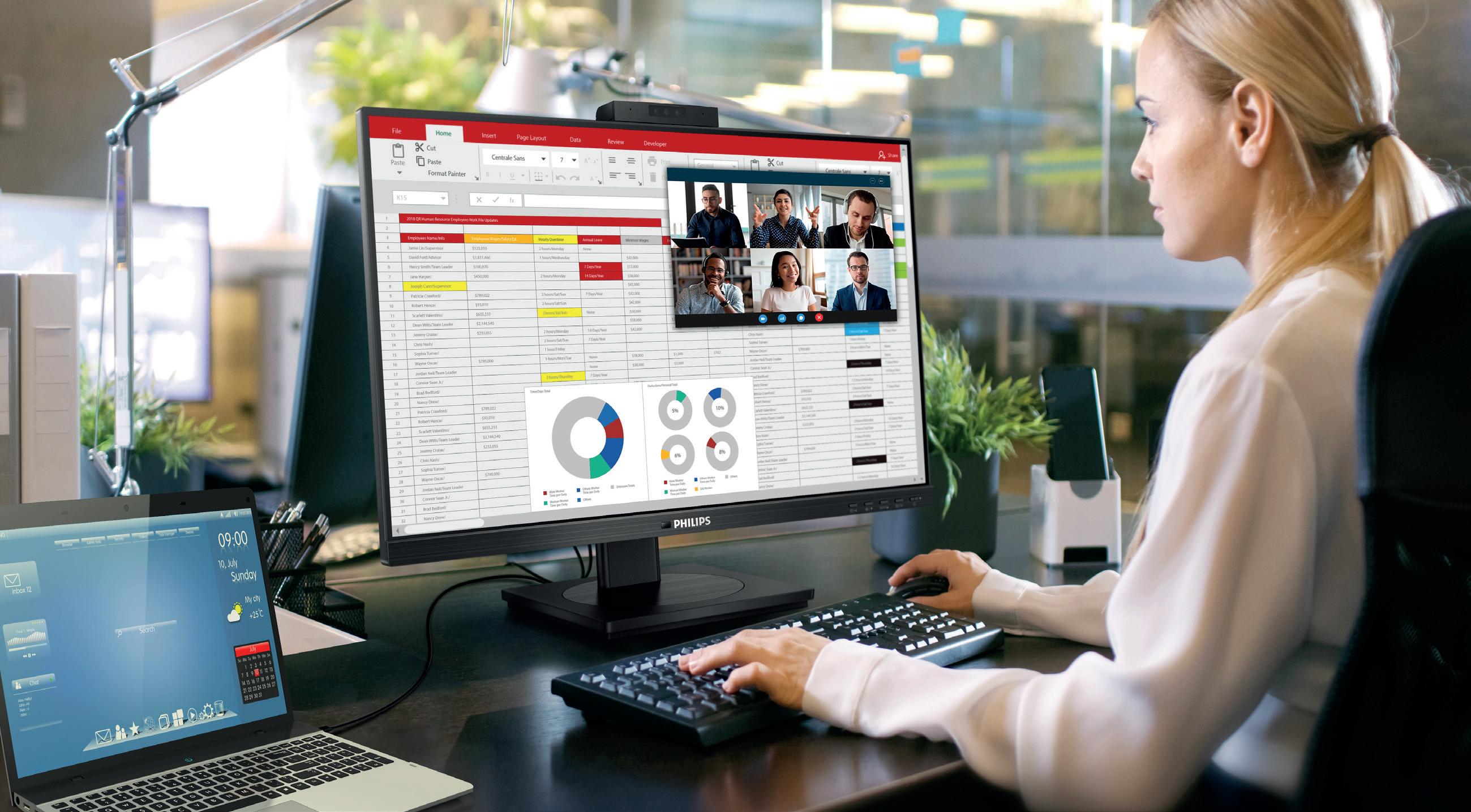



B
276B1JH

Females are consistently outnumbered by males when it comes to computing subjects and careers. While this is slowly beginning to change, there is still some work to be done. We examine why it’s important to have gender balance in computing, and what initiatives there are to encourage this

The number of young women in the UK applying to start computing degrees in 2024 has risen by ten per cent on last year, according to BCS, The Chartered Institute for IT. In total there were 18,880 applications from UK 18-year-old women to study Computing at university this year, up from 17,140 in 2023.
While male applicants still outnumber females in computer science by 4.1 to 1 this year, the gap has closed slightly from 4.4 to 1 at the same stage in the application cycle in 2023, BCS found.
But why is gender balance important in the field of computing? As technology plays such a crucial role in our lives, having more people from different backgrounds involved in its creation can help break down gender and racial economic inequalities. What’s more, gender diversity reflects the customer base as such a E

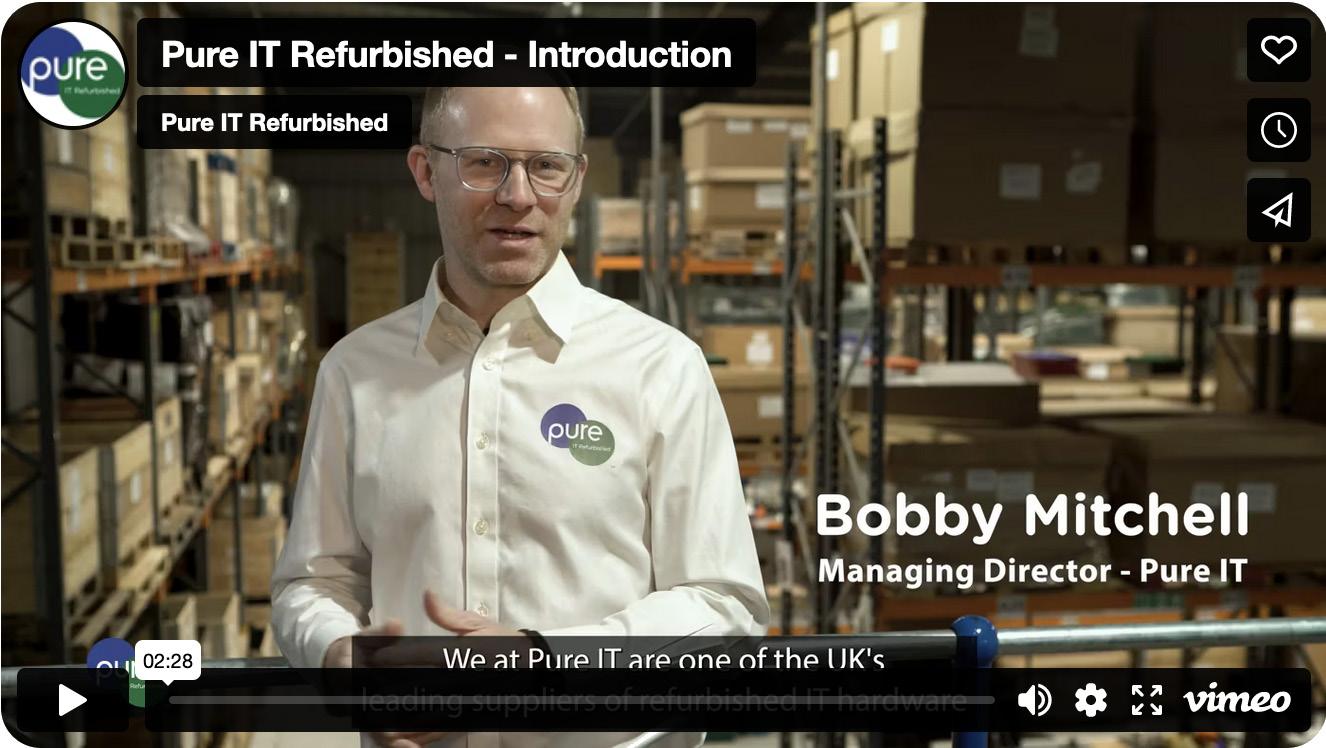

While AI is supposed to be neutral, it’s made by humans, which means it has the same bias as we have
F variety of people use technology. A gender imbalanced workforce in computing and technology can mean that the needs of all users are not met.
Gender imbalance in computing could become a particular issue when it comes to the development of artificial intelligence. While AI is supposed to be neutral, it’s made by humans, which means it has the same bias as we have.
The first step towards addressing this is making sure training datasets are as diverse as possible, not only in terms of gender, but also ethnicity, age, sexuality and so on. And the people developing AI also need to be from different backgrounds.
Gillian Arnold, President of BCS, The Chartered Institute for IT, said that the recent uplift in women choosing computing degrees was good news for the future safety and fairness of AI. She said: “There’s still a long way to go until we have the truly diverse tech profession we need to ensure emerging technology like AI benefits everyone. That also includes creating a more inclusive culture across the technology profession itself.

“Diversity is more than just a concept when it comes to teams creating AI – reducing bias is a critical factor in all teams if we are to get more innovation in areas like medical diagnosis.
“People from every background need to be encouraged by the demand for computing and know that the tech profession needs them.”
An initiative called ‘I Belong’ has been launched to support more girls into computer science. E







As technology plays such a crucial role in our lives, having more people from different backgrounds involved in its creation can help break down gender and racial economic inequalities
F Run by The National Centre for Computing Education (NCCE) and STEM Learning, the initiative was recently celebrated at Tech for Success event at Tata Consultancy Services (TCS) in London which saw more than 50 people networking to bring together education and industry to focus on the important mission of building STEM opportunities for women and girls.
The I Belong initiative aims to help teachers and leaders understand the barriers to girls’ participation in computer science and plan to overcome them.
Computer science is the fastest-growing STEM subject - but girls are consistently outnumbered by boys. In 2023, only one in five GCSE Computer Science and 15 per cent of all A level Computer Science entries were from female students in England.
The I Belong initiative offers schools solutions to this including teacher CPD and access to Computing Ambassadors – industry professionals who visit classrooms and inspire young people into a computing career by explaining their successful and rewarding career journeys.
It also provides practical, useful and free resources including posters to put up in classrooms, an evidence-informed handbook,
teaching resources and pedagogical guidance to support their classroom practice.
Séverine Trouillet, STEM Learning’s CEO, said: “The I Belong campaign is critical to help build an inclusive subject where girls feel they belong and can succeed. If girls feel they belong in tech, everybody benefits. E


DISCOVER INNOVATION AT YOUR FINGERTIPS WITH OUR NEW GOOGLE EDLA CERTIFIED INTERACTIVE TOUCH DISPLAYS.
Ready to redefine communication?
Get in touch with us and begin your journey towards interactive excellence now
Contact us at sales_uk@newline-interactive.com or visit our website www.newline-interactive.com/uk
F “Choosing to study Computer Science can be really empowering for students – it opens a huge world of opportunity to them. In an increasingly digital world, we need to ensure that the subject is inclusive, and that we are getting the best talent in the subject for the future. That starts in education, which is why the I Belong programme is pivotal to us moving the dial on the perception of computer science as a male-dominated subject and field.”
Amy Shocker, head of corporate social responsibility at TCS, said: “We have been collaborating with STEM Learning for many years, helping our associates become STEM Ambassadors that inspire the next generation of digital innovators, as well as bringing our flagship STEM programme, goIT, into schools.
“We continue our commitment to elevate technology startups, not-for-profits, and organisations striving for positive change in the field. Partnering with NCCE and STEM Learning is an important aspect of this work, building equitable and inclusive pathways for marginalised groups, young people, women and girls underrepresented in the technology space.”
The event included a presentation of certificates to the first schools to complete the programme, which were presented by Karen Blake, co-CEO of Tech Talent Charter, and Jenny Oldroyd, director of curriculum and general qualifications at the Department for Education.
A guest panel of female tech innovators then

The Government’s National Cyber Security Centre runs an annual CyberFirst Girls Competition, which seeks to inspire young women to pursue careers in cyber
discussed the importance of supporting females into STEM subjects and careers.
Karen Blake said: “We know the diversity of thoughts makes for the most innovative teams. We need those different opinions coming in to make the best products; our technologies are a reflection of us.”
The I Belong initiative is looking for teachers who are paving the way for girls in computer science to join the mission by becoming I Belong Champions. This involves completing the ‘Encouraging girls into GCSE computer science’ course.
The I Belong Champions help schools to create a sense of belonging for girls and underrepresented groups into computing. They take a lead role in helping their own school progress towards the NCCE Computing Quality Mark, with a focus on improving Equity, Diversity, Inclusion and SEND self-assessments.
Champions also embed inclusive practices through staff support and training, signposting information and guidance, as well as encourage teachers to benefit from evidence-based teaching and learning approaches, and inclusive enrichment activities provided by the NCCE. They also work to share effective practice and examples of success with other educators through forums and teacher networks.
The Government’s National Cyber Security Centre runs an annual CyberFirst Girls Competition, which seeks to inspire young women to pursue careers in cyber.
The competition sees teams use a range of cyber skills to compete in code cracking, decrypting messages and solving puzzles. More than 12,500 girls across the UK took part in the 2023/2024 competition, with 13 teams claiming the top prize. It saw the most teams and schools take part since its inception seven years ago, with 3,608 teams from over 750 schools participating. E

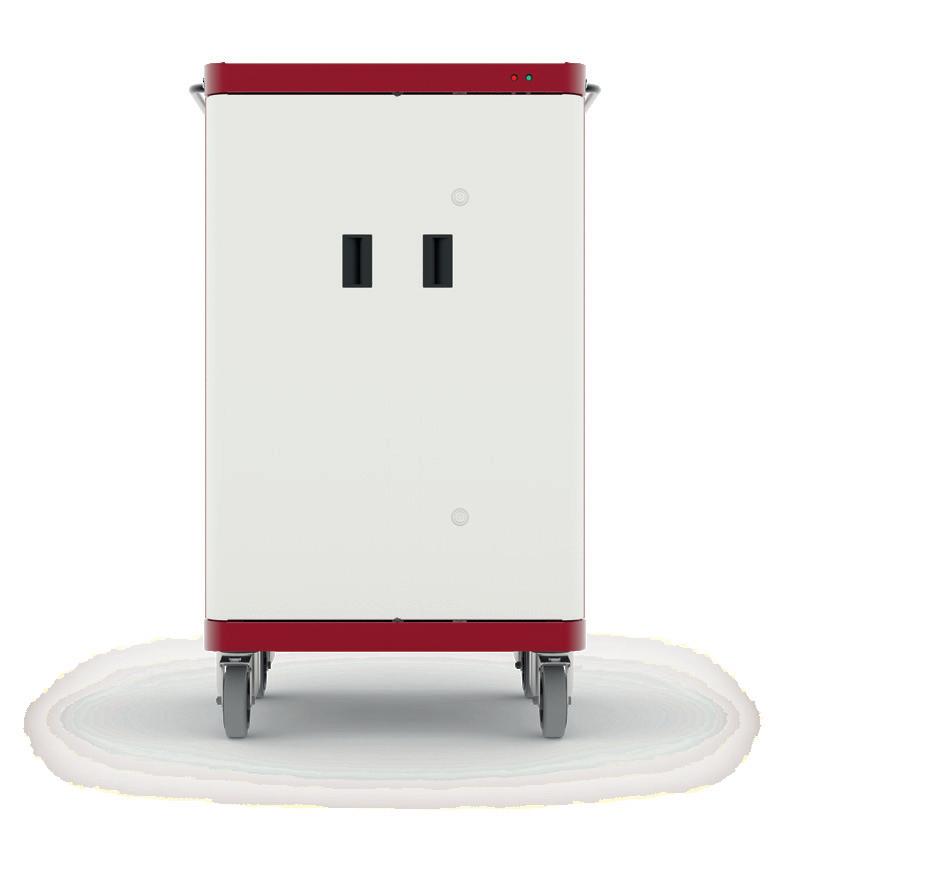
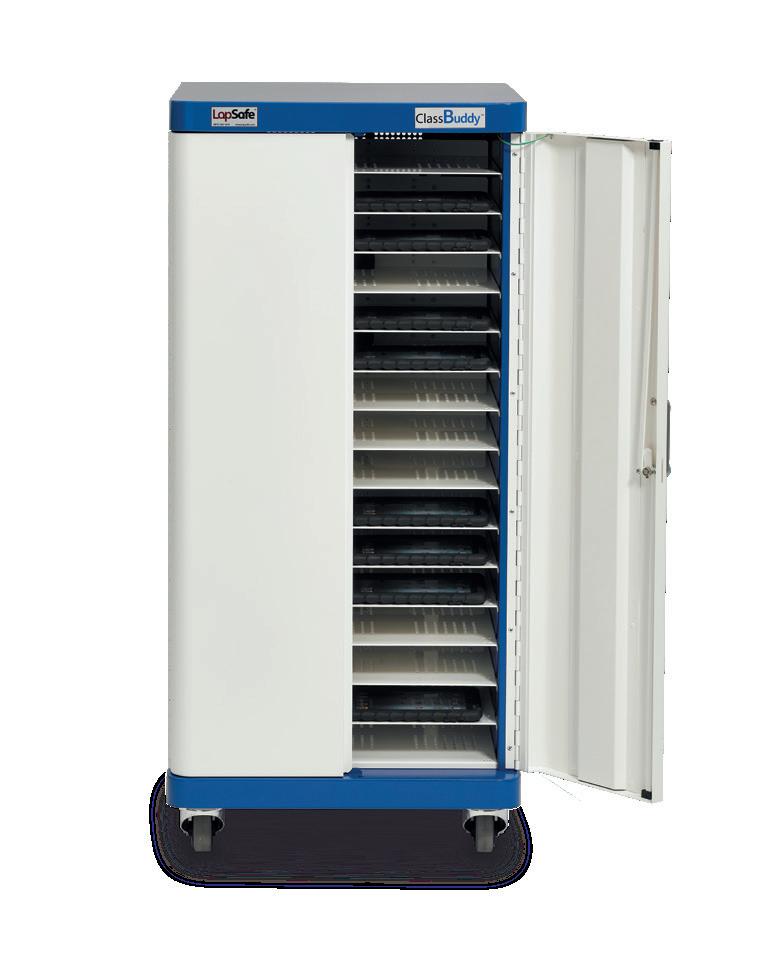


F The contest is designed to encourage girls to explore the world of cyber and technology, helping to address the lack of diversity in the UK cyber workforce, where women currently make up just 17 per cent.
Chris Ensor, NCSC deputy director for cyber growth, said: “Congratulations to all the teams who took part in this year’s CyberFirst Girls Competition, they’ve shown some incredible talent, teamwork and dedication.
“A special mention to the respective winners, whose success is not just a triumph in the competition but a great demonstration of breaking barriers and addressing the need for greater female representation in the cyber security industry.
“I’d like to thank all the teachers, for the incredible effort they put in to inspire their students and our industry partners for their efforts in making the competition so successful.”
Advances in technology are going to continue at a rapid rate, and technology will continue to penetrate our daily lives. We therefore have to ensure that the people developing technology








The only clinically-proven mental health solution, designed to boost student resilience in 5 weeks!

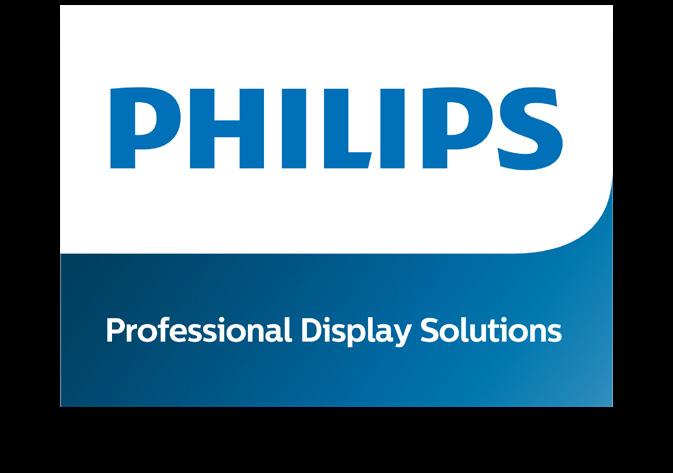

Discover the latest Philips Collaboration displays now
Philips Professional Displays from PPDS bring education settings to life. In the classroom or lecture theatre, in the back office and around campus.
Standalone or networked, interactive or static – with the solution-based approach from PPDS, the display is just the beginning. Harnessing the power of your familiar software, and bringing new, intuitive solutions into the mix, whether you need to enhance collaboration, to engage students on site and working from home, or to inform the whole-campus community, move confidently into the future with Philips Professional Displays.
Learn more at ppds.com/education

Hybrid, blended and distance learning are not passing trends, they’re enduring themes, as emphasised by Frank Trossen, global business development director at Phillips Professional Display Solutions (PPDS)
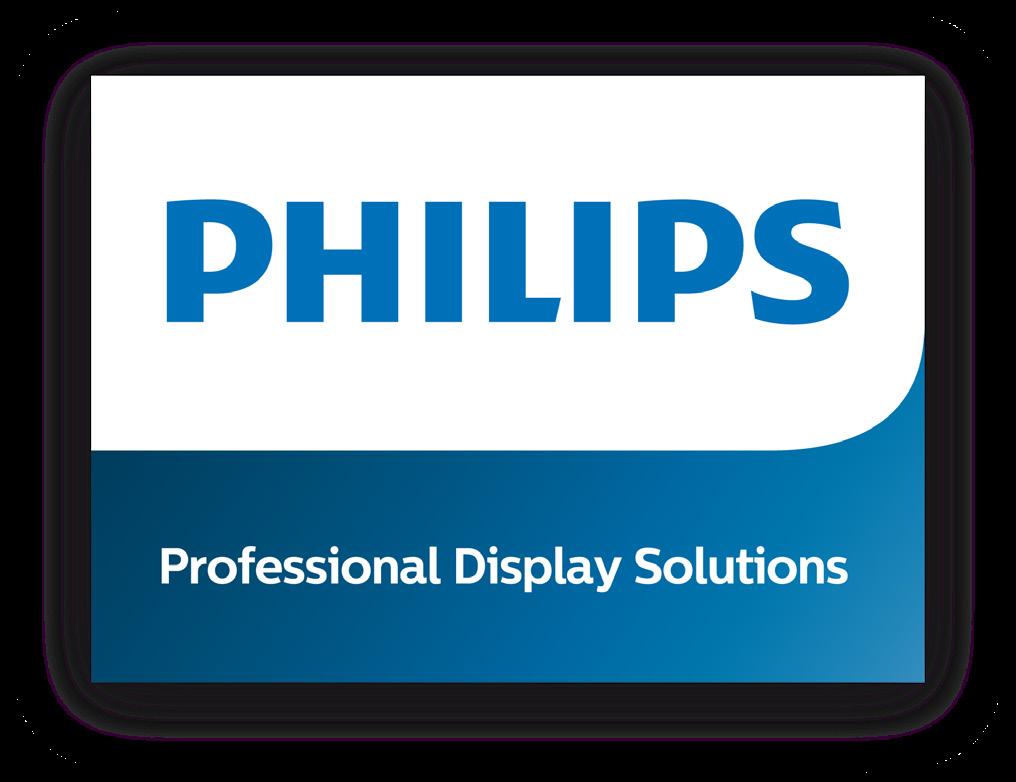
Hybrid learning, often misconceived as a pandemic-induced phenomenon, had already established itself in education before 2020. The lockdowns merely accelerated its adoption. Hybrid, blended, and distance learning, while distinct, share the common goal of engaging stakeholders in education –teachers, students, or contributors – in learning from various locations. These approaches are not passing trends but enduring themes.
The significance of hybrid learning lies in its ability to cater to diverse teaching and learning styles. With a range of learning needs and styles, accessibility becomes crucial, encompassing resource availability and flexible learning environments. Whether accommodating students with extracurricular commitments, those struggling in traditional classrooms, or those with distinct media consumption patterns, hybrid learning fosters inclusivity, preventing students from slipping through the cracks.
Beyond immediate educational benefits, hybrid learning prepares students for the post-education world, where 92 per cent of jobs demand digital skills, and 83 per cent of global employees prefer a hybrid work model. This underscores the essential role of digital
learning in developing students’ communication, productivity, and efficiency skills.
Despite the familiarity gained during lockdowns, establishing a hybrid learning environment remains challenging. Educators must juggle inperson and online engagement while ensuring content accessibility. Technology, such as the Philips Collaboration 4152 Series, is designed to address these challenges. Interactive displays, paired with videoconferencing tools and intelligent software like Philips Genius, create dynamic classrooms, enhancing engagement for on-site and remote students.
Investing in classroom technologies for hybrid education requires careful consideration of factors like size, interactivity, operating system, brightness, blue light filtering, and sustainability. Software choices should cater to various platforms and devices, ensuring intuitive use and compatibility with tools like Google Classroom.
The Philips Collaboration 4152 Series, Philips Genius teaching software, and Philips ScreenShare technology are tailored to the evolving needs of education. These solutions promise a seamless blend of in-person and remote learning experiences, contributing to the future of education. M
www.ppds.com/education


• Pupils coming to class with uncharged devices
• Poor cord organisation on large carts led to confusion
• Wasted class time due to retrieving or returning devices
• Damage to devices being kept in lockers Solution
• Core16 USB on Rollers
• Devices kept on Towers, positioned in central location
• Organised cords and coloured shelves eliminate device confusion
• Pupils retrieve and return devices in transition time
Pupils at Richfield Middle School (primary school) come to class every day with charged and undamaged Chromebooks like clock work. And the teachers have nothing to do with it.
The Holy Hill Area School District has adopted a model that keeps primary schoolers’ Chromebooks in one central location. Chromebooks are stored and charged in PowerGistics charging Towers in the library and remain there every night.


“They have been fabulous and it has streamlined our process with the Chromebooks and the students.”
— Krisi Harwood, Library and Technology CoordinatorWisconsin, U.S.
Serves pupils at the Primary School levels. The schools included are Friess Lake Elementary School and Richfield Middle School.

Bett 2024 attracted over 30,000 of the global education community to view the latest innovative educational technology and hear from inspiring figures and education professionals
Bett 2024 took place from 24 to 26 January at London’s ExCel and attracted over 30,000 of the global education community, over 2,000 children, and 300 inspirational speakers to get a taste of innovative technology for the education sector.
Education Secretary Gillian Keegan took the keynote address, setting out the importance of evidence and innovation in the DfE’s approach to Artificial Intelligence (AI).
She encouraged the sector to innovate and explore the potential of AI to transform teaching and learning, and argued that, alongside robust regulation and an evidence-based approach, international collaboration is key if we are to
take advantage of the opportunities offered by this emerging technology.
She told the conference: “Since I stood on this stage in March last year, we’ve seen generative AI continue to develop at pace and spark conversations all over the globe. Those conversations have highlighted some of the opportunities and the challenges that AI might bring.”
She continued: “This country’s EdTech sector contains a wealth of innovators and leaders who are looking to the future.
“Alongside them are the brilliant educators, hundreds of whom responded to our recent call for evidence which told us how generative AI E








F is saving hours of planning time and helping to reduce workloads.”
The speech coincided with the publication of a report from the Department for Education on AI, which contains insights from interviews with teachers, educators and academic experts, reaffirming the view that Generative AI could have a transformative impact on education.
At Bett, the Education Secretary also highlighted how the government is creating a forward-looking skills sector that is equipped to deal with AI. Last year, over 22,000 people started a digital apprenticeship, while digital Higher Technical Qualifications (HTQs) and Skills Bootcamps are helping both young and adult learners to develop their skillset and grasp the opportunities associated with AI.
The use of AI in the classroom was also discussed by Rosemary Luckin, a UCL Professor renowned for her research into the design and evaluation of educational technology, and Dan Fitzpatrick, the author of the acclaimed book, The AI Classroom.
Lee Parkinson, the popular blogger known as Mr P ICT, spoke about how emerging technology, such as language-based AI models, can save teachers significant time with different admin tasks.
The topics that matter
There was a substantial focus on SEND and Neurodiversity at Bett 2024. Documentary presenter extraordinaire Louis Theroux took to the stage to interview Loyle Carner about social inclusion in schools, neurodiversity, and the ADHD cookery school he founded.
Former Love Islander and Global Ambassador for DeafKidzUK, Tasha Ghouri, spoke about her experience as a deaf person in mainstream school and how higher education can become more inclusive of students with additional needs.
Dame Darcey Bussell DBE, dancer and founder of DDMIX Trust returned to Bett this year, and delivered a powerful speech on the importance of movement for both children and adults. Darcey Bussell explained how staying active is crucial for health and wellbeing and had attendees up and dancing.
Jason Arday, a renowned sociologist best known for his research on race and racism, also took to the stage. His appointment as Professor of Sociology of Education at the University of Cambridge made him the youngest Black person ever appointed to a Professorial Chair and one of the youngest people ever to be
Education Secretary Gillian Keegan took the keynote address, setting out the importance of evidence and innovation in the Department for Education’s approach to Artificial Intelligence
appointed to a full Professorship in Oxbridge’s history.
Meanwhile, former Lioness Alex Scott MBE captivated the audience with her talk about overcoming racism and sexism to succeed in a male-dominated sport.
Baroness Floella Benjamin, former presenter of the iconic children’s TV programmes Playschool and PlayAway, opened the final day of Bett 2024, speaking about diversity, inclusion, wellbeing, and leadership. From 2006 to 2016, Floella was Chancellor of the University of Exeter and in 2010, entered the House of Lords, where she speaks on diversity, equality and children’s issues.
Also presenting was Namya Joshi – an inspiring 16-year-old Minecraft Student Ambassador at Microsoft. She has spent the last five years designing and delivering free coding workshops for more than 15,000 teachers and young people, especially girls, in India and all over the world. Namya works passionately to raise awareness about social issues using gamebased learning with STEM to provide solutions for the problems facing humanity. E


Photo editing, page layout, graphic design and illustration tools for Mac, Windows

There was a substantial focus on SEND and Neurodiversity at Bett. Documentary presenter Louis Theroux took to the stage to interview Loyle Carner about social inclusion, neurodiversity, and the ADHD cookery school he founded
F Michael Rosen, one of Britain’s best loved writers and poets for children and adults, returned to Bett to discuss what it means to understand a story. Michael is currently Professor of Children’s Literature at Goldsmiths, University of London where he co-devised and teaches an MA in Children’s Literature. Michael is also a popular broadcaster and has presented BBC Radio 4’s acclaimed programme about language, ‘Word of Mouth’ since 1998. Michael has published in the region of 200 books for children and adults, including three booklets for teachers on writing and reading.
Bett 2024 discussed the very real threat of cyber attacks on the education sector. There was a session on data breaches and how to collectively respond to a cyber attack on a school. Joe Cockcroft and Martin Wilson from the North East Business Resilience Centre (NEBRC), Ed Renwick from Acronis and Wendy Pattison from Framwellgate School shared

insights on their experience of a cyber-attack, passing on invaluable lessons for others on how to prevent similar attacks in the future, with a focus on preventative technologies and processes.
Jorge Rodriguez Vargas from Intel also took on the topic of cybersecurity, looking at new tools for a comprehensive approach to growing threats. He discussed how the latest security technologies, built into the PC hardware, can help shield data from theft and tampering, safeguard access, strengthen real-time threat detection, and speed recovery from attacks. E

If only protecting your pupil, student and young person’s data was as simple as protecting them in the school grounds.
Pupils, students and young people learning within a safe and secure digital environment is paramount to their development and essential if they are to achieve the best possible outcome from their journey through education, SolarNet are here to help.
Cyber criminals are focussed on the education sector with Ransomware and Phishing attacks becoming more prevalent. These attacks are more sophisticated than ever and are more likely to succeed unless your school has the necessary security controls to stop them and prevent you becoming a victim of cyber crime.
SolarNet offer a comprehensive set of products and services that will keep your school ProtectEd® at all times.
In a complex I.T environment it’s not always easy to obtain a reliable and comprehensive I.T asset register which identifies:
• All assets including where they are located
• Asset condition and any security risks posed
SolarNet offer an automated I.T asset management system which:
• Discovers all I.T assets and their location on your network
• Identifies I.T asset vulnerabilities
• Integrates with support systems to help manage remediation activities
• Notifies stakeholders of I.T asset issues before they become a bigger problem
• Provides continual checks of I.T infrastructure to aid with compliance, e.g., Cyber Essentials
ParentPay is an essential service used by pupils and parents to pay for anything from meals to trips but what would happen if this suffered a cyber attack? What if financial data were stolen and used fraudulently, what impact would that have on your school?
SolarNet in partnership with AdamNetworks offer a Zero Trust solution tailored for education. Deploying our Zero Trust capability ensures your school remains protected, keeping your ParentPay services and school operating normally without risking the loss of financial data.
We work with a world-leading network of Trusted Partners including:





ADAMnetworks® Toca.io Cybersixgill Orpheus Cyber Rebasoft

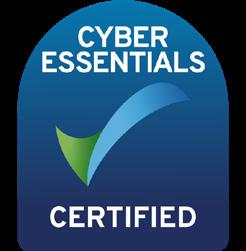
There is an increasing reliance on schools being able to deliver education digitally, whether that’s through online learning portals, or through their own home learning environment. How long could your school operate without such a valuable learning aid before it started to affect a student’s ability to achieve their true potential?
SolarNet can stop cyber attacks from becoming a reality and provide peace of mind knowing your school will continue to operate within its digital environment without disruption.
Learning within a safe and secure digital environment is crucial to a student’s development and essential if they are to achieve the best possible outcome from their journey through education.
That’s why SolarNet offer the ProtectEd® set of products and services tailored for education delivered through our trusted partner network, enabling all educators to have the same cyber security protection that global enterprise-level businesses benefit from today.
Education is not immune to the effects of complex and tedious manual processes which get in the way of delivering positive outcomes, leading to frustrations felt by staff, students and parents alike.
That’s why SolarNet offer the AutomatEd® set of products and services, tailored for education and focussed on delivering workplace automation. No matter what processes, systems or technologies are in use, SolarNet can provide guidance on how to maximise efficiencies. We believe in working smarter not harder through combining capabilities, and by working closely with teams in education to affect positive change.

We are approved sponsors and suppliers for:




TableTalks was a new feature for 2024, which connected individuals from schools, universities and governments for roundtable conversations based on their primary topics of interest, such as AI, SEND or cybersecurity.
The Tech User Labs were another new feature which allowed delegates to get the most out

of their existing tech with working groups and demos from the top education technology experts in the world, through interactive 45-minute sessions.
The ExCel centre was home to rows of exciting exhibitors, showcasing the latest technological innovations that can help the education sector.
YPO, one of the UK’s largest public sector buying organisations, launched a brand new edtech software platform, Learning Box, that aims to provide schools with access to the latest programmes to support education.
Similar to a streaming platform, YPO’s Learning Box will give schools access to a wide range of technology through a single log-in. Each equipped school will be able to customise its programmes and bundles, consolidating contracts and billing to ensure that only what is used is paid for. Teachers will also be able to access live analysis progress, highlighting individual strengths of pupils and areas which may require extra support.
Promethean debuted its new Explain
Everything Advanced software solution, which is designed to revolutionise lesson creation and delivery. It has customisable templates, a large library of shapes and clipart. Designed to be used for in-person, remote, and hybrid E


With ActivPanel 9, there’s never been a better time…
Give your school the best there is, from the UK and Ireland’s number one interactive flat panel display brand*. Increase student engagement and improve learning productivity with:
Connectivity
The only interactive panel with ActivSync technology
Simplicity
Easy to use, so you can focus on teaching
Security
Enhanced security protects your personal data
Adaptability
Ideal for all learning environments
Longevity
Built to last and powered with robust capabilities
prometheanworld.com/gb
Explain Everything Whiteboard now included on every ActivPanel 9
Create and deliver captivating lessons with one of the most intuitive, easy-to-use, and powerful whiteboard apps available.
ActivPanel 9 is also backed by free training and support!
Learn more about the benefits of upgrading, schedule a free demonstration today.


F environments, Explain Everything Advanced allows teachers to record their lessons and then edit them so they can be shared with students anytime.
ViewSonic debuted two new software solutions: ClassSwift and TeamWork. ClassSwift is a real-time class interaction and management tool that empowers teachers to assess student comprehension and personalise learning experiences, and TeamWork is a real-time collaborative whiteboarding software with ready-made templates, transforming any space into a digital workspace.
Additionally, ViewSonic showcased its upcoming 110” 4K ViewBoard interactive display with advanced multitasking capabilities and the new Meeting Space Solution for Microsoft
Teams Rooms for enhanced hybrid learning efficiency.
Philips was also present, showcasing its latest generation of hardware and software innovations, including the official global launch of its 4K, interactive Philips Collaboration displays for Education, together with an official preview of its Philips Genius education software suite – its most advanced classroom solution to date.
UBTECH meanwhile attracted visitors with its programmable robots, which help to enhance AI literacy in young people.
Kids Judge Bett took place again this year, with pupils from around the UK selecting their favourite innovations on display.
Kids Judge Bett was created and organised by Katy Potts, Computing and Online Safety Lead for Schools at Islington Council, in partnership with the British Educational Suppliers Association (BESA). This popular event was first launched in 2016 to help raise the profile of pupils’ voices, the importance of critical thinking around technology, and understanding of the incredible potential of EdTech.
The students announced the winners of alongside celebrated poet and children’s author Michael Rosen. Winners included Photon Entertainment for Best Robotics for Inclusion Award, and Tech She Can for Best Gender Equality in Education Resource. L
FURTHER INFORMATION
uk.bettshow.com

22 - 24 January 2025 ExCeL
Imagine the scene… 30,000 visitors from 129 countries, ready to connect and collaborate, 616 companies showcasing the latest EdTech, more CPD than ever before and 400+ speakers lighting up the stage with passion and innovation…
THIS was Bett UK 2024.
“Teachers, if you are looking for the best professional development, you need to be at Bett 2025!”Laura Fulton - Teacher

With teachers from across the globe making the most of hundreds of hours of content at the Arena, onstand CPD sessions from the likes of Canva, plus our brand new Tech User Labs, Bett 2024 was a CPD seeker’s dream!
The Ahead stages were buzzing, hosting speakers such as Donald Clark and Carla Aerts exploring the profound impact AI will have on learning, and therefore Higher Education. We welcomed back a Bett favourite, The AI Educator - Dan Fitzpatrick - to the arena, who provided incredible insights on how to embrace change when implementing AI into education.
Keep up to date with all things Bett UK 2025
“Tech User Labs was really informative and hands on, getting to try and learn in person with the experts. Also hearing about upcoming developments the tech may have is great for keeping an eye on the future.”
Camilla Evans - Head of STEM, Wishford Education
The launch of Tech User Labs and TableTalks
Tech User Labs connected over 1,600 educators with the top education technology experts in the world across 16 sessions. With workshops from Microsoft, AWS, Meta and more, educators loved getting hands-on with tech, discovering tutorials on new features, asking questions and learning how to make the most of their existing tech.
TableTalks connected peers through powerful conversations. Sharing experiences, openly discussing challenges, and tackling these together with peers from around the world is a rare opportunity for educators. With 10 trending topics on the table, 1,000 educators joined 130+ roundtables creating a space where their voice counts.
The show may be over but this is just the start of your EdTech journey!

“TableTalks was a new feature of Bett 2024, and I can’t recommend this innovative programme enough. Participating in this roundtable discussion, I was able to learn, grow, and debate with likeminded individuals”
Erika D’Souza - Assistant Professor at University of TokyoFollow us on socials for exciting updates on Bett 2025
Dave Smith, head of partnerships and events at BESA, shares his experience of Bett 2024, which saw 64 of the organisation’s members exhibit their latest EdTech solutions
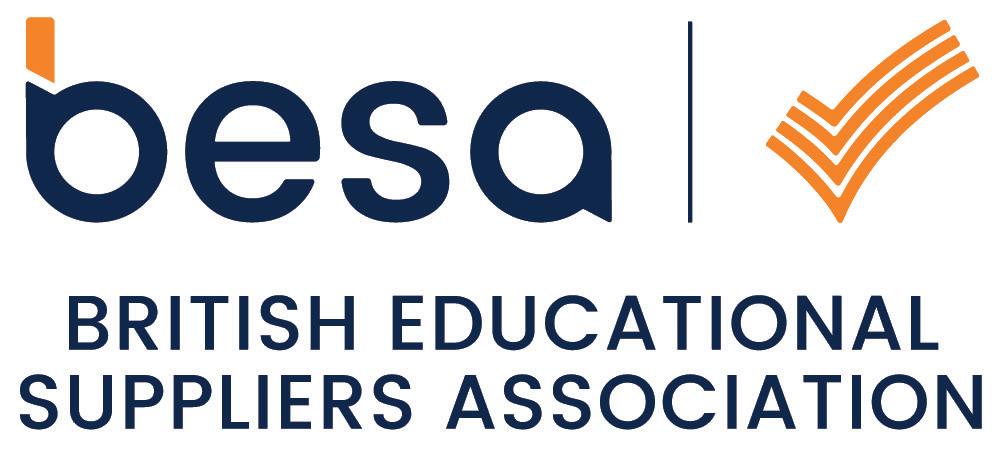
A standout addition to Bett 2024 was the Table Talks program. This initiative connected individuals from schools, universities, and government bodies based on their primary areas of interest, such as AI, student and teacher wellbeing, cybersecurity, and SEND/Inclusion. In one session, I joined a talk on the significance of digital strategy and growth. The session facilitated a rich conversation with participants, including representatives from schools, governors, and the digital team from an EU country, sharing valuable insights, tips, and successful approaches.
Another noteworthy event at Bett 2024 was the eighth edition of Kids Judge Bett, led by Katy Potts of Islington Council. This initiative, where children aged 7-13 years old choose the best exhibitor stands, concluded with an Awards Ceremony. Author and poet Michael Rosen presented trophies to the winners. This year’s student judges hailed from various locations, spanning from Cumbria to East London, just a 10-minute walk from the ExCeL, the home of Bett.
This year, 64 BESA members exhibited at the Bett Show. BESA’s deputy director general Julia Garvey opened the show alongside Secretary of State for Education, Gillian Keegan MP and Louisa Hunter, Bett Director.
BESA and members exhibiting at Bett UK got 2024 off to a strong start, building connections with delegations from around the world. Julia accompanied Gillian Keegan MP on a tour of the show to learn more about BESA members exhibiting at Bett.
Julia and Peter Doyle, BESA’s policy manager accompanied Schools Minister Damian Hinds MP, Sir David Davis MP and Lord Offord to visit BESA members stands at the show. BESA members also met with VIP visitors from the Saudi Arabia Ministry of Education, Korean Ministry of Education, Lebanese EdTech syndicate, Brazilian Regional Government Leaders, India and Azerbaijan.
Julia was also a key part of the Celebrating Women in EdTech event at Bett connecting women from across the sector, and also presented on the panel discussing innovation in teaching and learning through AI as part of the launch of ITN Business’s EdTech programme.
BESA also helps run the Bett Global Futures area and I was on hand during the show to support the brilliant UK and international EdTech startups exhibiting there.
Produced in association with BESA, the Bett Awards are a celebration of the inspiring creativity and innovation that can be found throughout technology for education. Winning an award at Bett means you can showcase your organisation and its level of excellence. We were delighted to see BESA members making the list of winners and being recognised for their contribution to innovation in the industry. M
FURTHER INFORMATION
www.besa.org.uk
Management Information Systems (MIS) should simplify tasks and streamline processes. But what should schools do if they are unhappy with their current MIS provider?
As we navigate the digital revolution in education, schools now have more choice than ever about what technologies to adopt to help their pupils, and their school community, thrive.
At Compass, we believe that choice is powerful. We also believe that the education of young people is too important for schools not to have a choice when it comes to selecting their best technology, especially a school’s Management Information System (MIS) that sits at the heart of any digital strategy.
One of the biggest challenges schools face currently is that many of them are still using traditional, inefficient systems that cannot cope with the modern demands of education. These systems often create more work for teachers, administrators and data managers, rather than simplifying tasks and streamlining processes. Worse still is that many schools are finding themselves trapped in long-term contracts and unable to easily switch their MIS provider, stripping them of their power of choice.
As an MIS provider, our mission is to make the school day more productive, more impactful and more enjoyable. We’ve been fortunate to watch this mission come to life in our amazing schools, and have seen the things that they really value: a strong partnership, a shared commitment to make things better, and a high level of support and flexibility so that making the change to a new MIS is an empowering process.

If schools are tied into a long-term contract with an MIS provider and wish to explore alternative solutions, then we promise that, for as long as they’re paying for their current MIS, they can switch to us and Compass will be completely free until their current contract ends.
We also promise that their migration will be done at a pace which suits them. We will even allow time for a trial phase with their real data before they go live. Why? Because we don’t want schools to be rushed or have to compromise their rhythm and priorities just because they’ve chosen to embrace something new.
We’re giving the power of choice back to schools, making sure they’re not just ready, but exceptionally prepared to handle the changes brought by the digital revolution in education. Rest assured, they won’t be venturing into this new phase alonewe’ll be right there with them, providing guidance every step of the way. M
FURTHER INFORMATION
https://www.compass.education/uk/post/ compass-choice-commitment-2024/
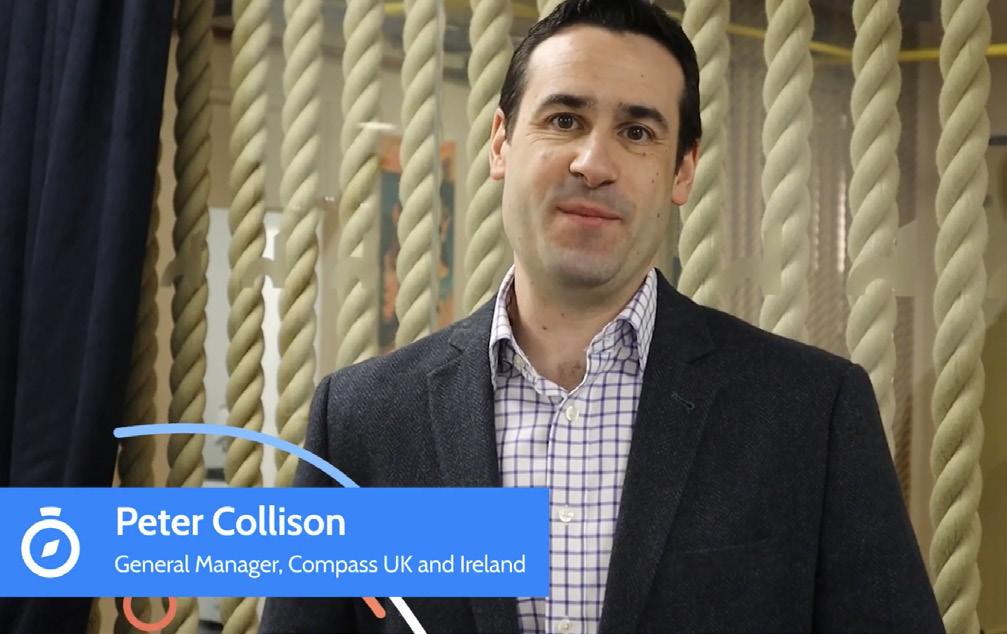
The annual conference is back again, and promises to be a must visit for any SEND professional

The Nasen Live conference will take place on 5 July at Vox Conference Centre in Birmingham. With the event less than six months away, organisers have promised to provide SENCOs, school leaders, teachers, and other education professionals with a unique platform to celebrate outstanding practice and provision for children and young people with SEND.
Visitors will have the chance to network and explore the latest developments in the SEND and education sector.
Attendees will also be able to update their knowledge and learn from evidencebased practice and practical examples.
There will also be an opportunity to access leading, award-winning exhibitors, as well as attend several seminars and keynotes delivered by key figures in the sector.
With delegate figures increasing year on year, and a feedback rate of over 90 per cent, this event is not to be missed.
An anonymous delegate who attended last year’s conference said: “I really enjoyed the show and came away with a buzzing mind on things I want to look at for our academy improvement next year.”
Another attendee said the conference was “full of great practice and learning.”
Our early bird tickets are now officially on sale! Early bird tickets are only available until 29th February* at just £79 (usual ticket price £99), so make sure you secure yours today. M
FURTHER INFORMATION
https://nasen.org.uk/nasen-live

*Ticketsmustbepaidforby31stMarch. Ticketpricesalsoincludelunchandlightrefreshments.
Coding is a fundamental skill in modern education. With a productagnostic approach, OKdo provides the equipment needed to support your school’s STEM journey, empowering educators and students alike

In today’s digital era, technology is pivotal for progress, making coding a fundamental skill in modern education. No longer niche, coding is essential for students to thrive and contribute to the future.
Introducing coding during formative years is crucial. Beyond coding itself, it fosters critical thinking, problem-solving, and creativity, enhancing students’ mathematical abilities and teamwork skills. Coding instils a growth mindset, preparing students for evolving careers.
Coding extends beyond a tech class, serving as a catalyst for cross-disciplinary learning. Projects, like creating webpages for English or building historical timelines, demonstrate how coding amplifies understanding across subjects. Partnering with a top-tier STEM provider is key, ensuring resources align with diverse needs for an enriching learning experience.
Clare Ford is an educator and founder of SwitchedON!, a website offering
education courses. She said: “Computer Science education is fabulous for starting with the end in mind and then reverse engineering – taking logical steps, one at a time, to create a bigger picture.” She added that this approach
“builds a growth mindset.”
Tech careers are rapidly evolving, creating a demand for STEM talent. Despite a growing interest in computer science courses, a skills gap persists. Salaries in tech-related jobs exceed national averages, emphasising the value of coding skills in today’s job market.
Closing the gender gap in computer science is essential. While there’s a notable surge in female candidates, there remains a disparity. Empowering girls with coding skills not only addresses the tech employment gap but also contributes to gender balance in various sectors. Nurturing this shift invites both genders to shape innovations for diverse needs and preferences.
For tailored guidance and a wide range of educational resources, OKdo is your partner for STEM excellence. With a product-agnostic approach, we provide top-notch equipment to support your school’s educational journey, empowering educators and students alike. M
FURTHER INFORMATION okdo.com
Following the launch of the updated Institute of School Business Leadership (ISBL) Professional Standards in May 2023, a new selfassessment and accreditation process has now been developed

The new ISBL diagnostic self-assessment tool will allow professionals to assess themselves and reflect on their areas of responsibility, experience and expertise across the various discipline areas of the ISBL Professional Standards.
The self-assessment is completed by identifying the level of practice that best fits a professional’s current areas of responsibility and levels of accountability through a set of simple, multiple-choice questions.
The tool has been designed flexibly to cater for both generalist and specialist practitioners across the sector: generalists may choose to complete all six discipline sections of the self-assessment, whereas specialists may choose to complete fewer sections that are relevant to their individual roles.
The only section of the self-assessment that is mandatory is ‘operational leadership’ because this is a core discipline area and central to all of those involved in school or trust operations.
On completion of the self-assessment, professionals will be provided with a report that summarises where they are in relation to each discipline area, their current identified practitioner level, and this can be used to assess developmental progress on an on-going basis.
The report can be used to identify areas of strength, as well as professional development opportunities which professionals may want to consider improving their knowledge, skills and experience within the relevant discipline area.
The self-assessment report is an important tool that members can use to support performance management processes, either for their own appraisal or with any members of staff they may line-manage.
Alongside this, ISBL has provided several supporting documents to assist in the performance management process including
a performance management template, guide and a personal development plan template.
The most important part of any performance management process is the professional conversation that occurs between the line manager and the staff member. ISBL would recommend that the self-assessment report is used as the basis for this conversation and the supporting documentation can be used to aid this in a structured manner to allow the setting of specific targets and priorities and identify appropriate professional development needs.
Once professionals have completed the self-assessment, they can then apply to ISBL for formal accreditation against the identified practitioner level.
To access the self-assessment and associated accreditation, you will be required to be a member of ISBL. You can use your accreditation to demonstrate your level of practice to your peers, and current and future employers as assured by your professional body and using sector endorsed standards. L
FURTHER INFORMATION
www.isbl.org.uk





A recent report from BESA confirmed a real problem with the school estate, and uniquely, delved into every aspect of school buildings, such as the quality of PE equipment and music facilities. Robyn Quick summarises what needs to improve
A school should be a place where young people can thrive and learn in a safe environment.
The Department for Education (DfE) recorded in 2022 that there were over 9.1 million pupils to look after in schools across the UK, each of whom is entitled to learning in a wellmaintained school environment. However, around 700,000 pupils are attending schools in major rebuilding or refurbishment.
This statistic comes from the National Audit Office’s report into the condition of school buildings. The report’s shocking findings then prompted the British Educational Suppliers Association (BESA) to commission a special survey into the condition of more than 900 schools.
It revealed even more issues with school buildings across the country. The survey was unique in that it looked at almost every aspect of school buildings, such as the quality of PE equipment and music facilities.
The DfE said they have allocated £15 billion since 2015 to make sure school buildings are in good condition. Most of the funds are given to local authorities, large multi-academy trusts, and large voluntary aided school groups, to invest in maintaining and improving the condition of their schools.
Despite this continued maintenance, however, BESA’s survey shows there are a large number of teachers who report working in under maintained schools. E



















Fast
Elite
Lifetime
Child
Unravelled

F You can read the full report here , but these are the key findings that stood out in the survey.
STEM
Science, Technology, Engineering and Mathematics (STEM) facilities were one of the worst to come out of the survey, with one third of schools reporting that the current level of investment in STEM facilities was harming learning outcomes.
These kinds of scientific environments are often more specialist than your average
Science, Technology, Engineering and Mathematics (STEM) facilities were one of the worst to come out of the survey, with one third of schools reporting that the current level of investment in STEM facilities was harming learning outcomes
classroom, and need a lot more monitoring. The survey also found that over 80 per cent of science teachers are concerned about the level of investment in STEM facilities.
The Association of Science Education said the lack of investment into these facilities will “directly and negatively impact the effectiveness of science teaching and learning.”
They added that it means students are often not able to access hands-on learning experiences as much as they should be able to.
“This research suggests that these benchmarks are not being met in schools across the country and as such, paints a bleak picture for the future of science education in the UK,” they commented.
SEND
Nasen reported in 2023 that there are over 1.5 million children in UK schools who have been identified as having SEND. This means they have special educational needs and disabilities, E

A dancer’s health, safety and artistic performance is partially defined by the floor and learning environment. Harlequin Floors explains why it is so important to choose wisely

Whether you are specifying a dance floor for the world’s leading dance companies or for classes in schools, colleges or universities, the same fundamental criteria apply. Wherever a student chooses to study dance, it is important to make sure that the learning environment is equipped to professional standards with sprung floors, mirrors, and barres.
Choosing the correct dance surface is vital for dancers’ health, safety, and artistic performance. All sprung floors are not the same and understanding the differences between various types of floors available is important. Experts in biomechanics have established a clear link between the quality of a dance floor
and the likelihood of injury, demonstrating that a floor with a consistent response and the correct degree of traction is vital. Dance creates impact energy. If the energy generated is returned to the body it can result in an array of joint problems, sprains, fractures, knee problems and tendonitis. Lower limb problems such as tendinitis, shin splints, knee pain and ankle strain can all be attributed to incorrectly specified sprung floors and can take several weeks of physical therapy and recovery time to correct. A dance floor that is impact absorbent and provides lateral foot support is essential. Harlequin is the global brand leader for sprung and vinyl performance floors and has a portfolio of dance and education clients from top universities and dance schools to the world’s leading dance companies including the Royal Opera House and Royal Ballet, Paris Opera Ballet, Houston Ballet and New Zealand Ballet. Harlequin has over 45 years’ experience manufacturing, supplying and installing professional performance floors and offer a wide range of sprung floor systems and vinyl performance floors to meet every requirement. M
FURTHER INFORMATION
For further information and advice about how to specify the right dance floor for your needs, please talk to our technical team on 01892 514 888. www.harlequinfloors.com or email: architects@harlequinfloors.com


Very few schools described any of their SEND facilities as “well resourced” with less than 20 per cent of schools indicating that their facilities for SEND were in a good state of repair
F and includes a large range of conditions and abilities.
Over 80 per cent of schools said they need specially adapted physical education facilities, but do not have them. If SEND children cannot participate fully in physical education, it can have a profound impact on their sense of independence and level of confidence.
It is not just in physical education that the survey found a disparity between SEND and their non-disabled peers. There is also a need for over half of schools to have specialised classrooms and therapy rooms for children with SEND. Most of the leaders at these schools want to introduce these, but simply cannot afford it.
Seventy per cent of SEND teachers are worried about current levels of investment. A lack of investment affects all aspects of a child with SEND’s experience at school. If a student uses a wheelchair or mobility scooter, for example, a ramp will usually be required to get into some buildings. BESA, however, found that almost 30 per cent of schools have concerns with accessibility features.
Very few schools described any of their SEND facilities as “well resourced” with less than 20 per cent of schools indicating that their facilities for SEND were in a good state of repair.
Almost 40 per cent of secondary schools reported having inadequate music facilities. A
positive finding in the survey was that primary schools are largely happier with the music department compared to secondary skills, but this could be attributed to the fact that the former requires less complicated kit.
Music Mark, a membership organisation focused on fostering an environment for excellent musical learning, said these statistics are “deeply concerning.” They said: “High quality facilities are an essential part of any child’s music education, they create space for children and young people to create, experience, and be transformed. The National Plan for Music Education sets out a vision for the power of music to change lives, where “Music must not be the preserve of the privileged few.”
The report also found that over 40 per cent of schools have inadequate music facilities.
On the Art and Graphic Design side of the coin, 40 per cent of schools reported issues with their facilities. While most secondary schools have a dedicated art and design facility less than 15 per cent consider it to be well resourced and in a good state of repair.
Michel Gregson, the CEO for the National Society for Education in Art and Design (NSEAD), said that “teachers are telling us that art and design facilities are under-resourced, poorly maintained, and in some cases non-existent.
“So much learning in art and design is through practical experience, working with materials and specialist equipment to develop skills and E




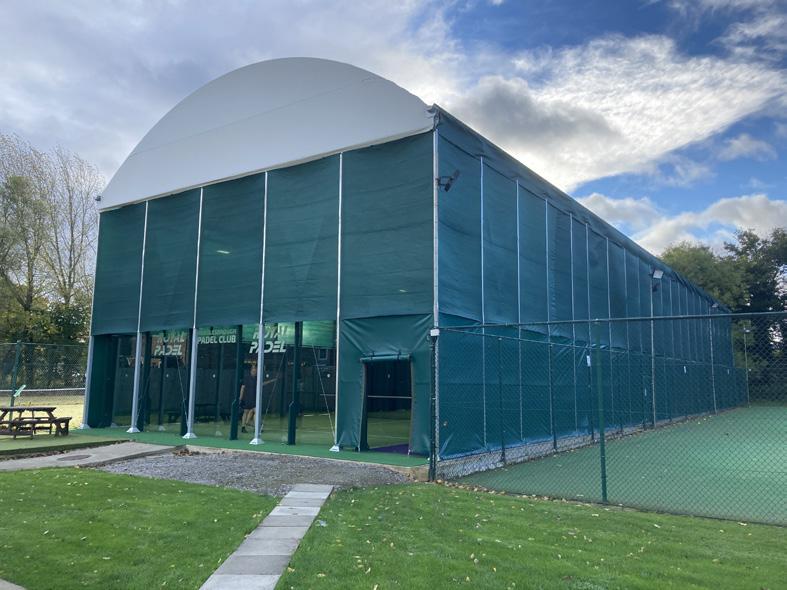
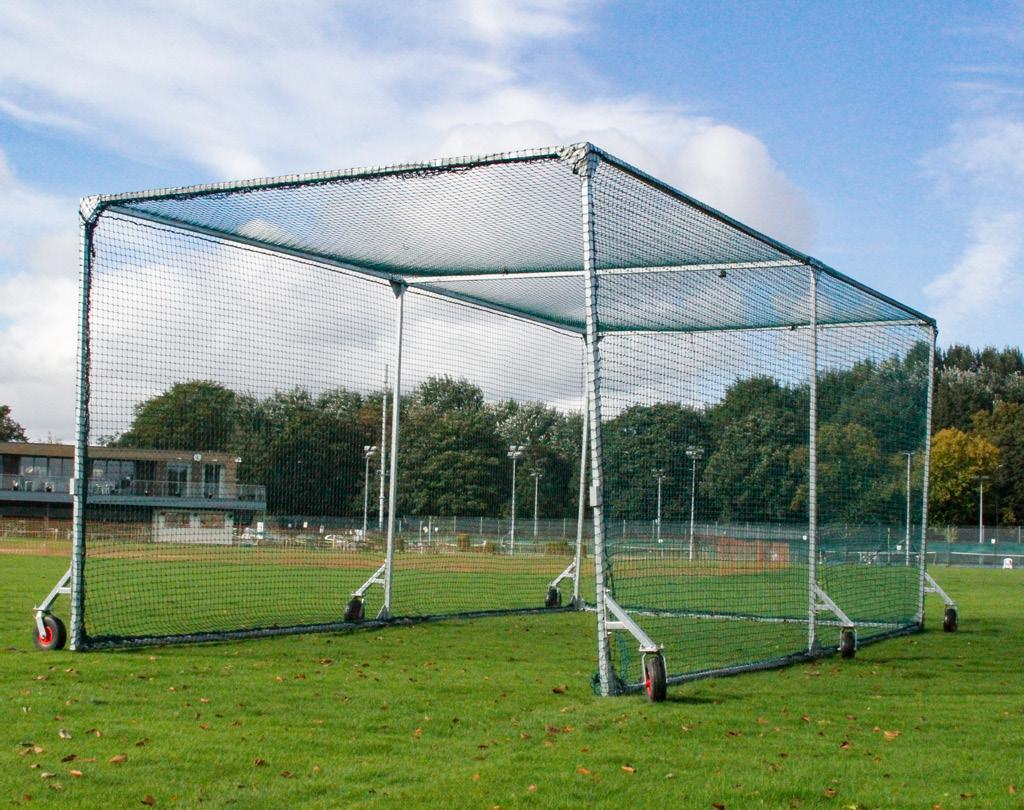









F understanding of a range of processes and disciplines. Pupils need access to well-equipped studios and classrooms. Pupils need the resources to support learning through making, but also access to digital devices, which are an essential part of learning in the subject.”
The term ‘communal spaces’ includes a wide range of facilities, including but not limited to bike storage spaces, bus services, playgrounds, school halls and outdoor sheltered areas.
Almost 40 per cent of schools have reported issues with the communal areas. Libraries and dance spaces were most likely to be marked as “excellent” or “good” by staff, but passageways and corridors ranked the worst. Around 65 per cent of staff said these areas were below adequate.
The staff room
BESA did not just survey spaces used by students; the school staff room also gets a look-in. They found that 35 per cent of respondents did not have a quiet space for staff to relax.
Having this kind of space to unwind between classes and teaching is essential to the wellbeing of staff. The staff rooms appear to have adequate furniture, but the actual use of space
seems to be an issue for many. Almost 70 per cent of respondents said the room is not large enough for school staff.
These spaces are often where teachers socialise with others, or just unwind a little. BESA said it was “concerning” to see these spaces underfunded.
Reading through these statistics can make the situation seem hopeless.
Caroline Wright, director general of BESA, said that the entire school estate would take over 400 years to rebuild, a figure which is clearly infeasible.
However, there were positive findings in the survey. For example, over 90 per cent of schools described their internet connection as reliable or better. As well as this, over 40 per cent of secondary schools now have a dedicated electronics workshop.
Most decisions to improve school buildings fall to the government and local authorities. We know there will always be staff, students, parents and carers who are dedicated to making sure that schools are providing that safe space to learn and thrive. L
www.besa.org.uk




State-funded education settings can now apply for a higher amount of funding to install electric vehicle chargepoints in their grounds – up to £2,500 per socket, in a new grant specifically for the sector. We examine how the new scheme works and what to consider before embarking on an electric vehicle charging infrastructure project
The United Kingdom reached its millionth battery electric car sales milestone in January 2024, according to figures from the Society of Motor Manufacturers and Traders (SMMT). What’s more, the UK now has a legally binding zero emission vehicle (ZEV) mandate in place, which requires 80 per cent of new cars and 70 per cent of new vans sold in Great Britain to be zero emission by 2030. With more and more electric vehicles joining the roads, the need for more local facilities to charge them is paramount.
Education settings can now apply for a higher amount of funding to install electric vehicle chargepoints in their grounds, thanks to a new dedicated grant for the sector,
called the Workplace Charging Scheme for state-funded education institutions.
State-funded education settings, including schools, colleges, nurseries and academies, can apply for the grant which provides up to 75 per cent of the cost to buy and install chargepoints, up to £2,500 per socket – which is a rise from the previous £350 which schools were able to receive through the Workplace Charging Grant.
The grant aims to boost the chargepoint facilities for staff and visitors, and has the potential to help schools generate revenue by making their chargepoints available to the public.
At the time of launching the grant, the Minister for the School System and Student Finance at E







Education settings can now apply for a higher amount of funding to install EV chargepoints in their grounds, thanks to a new dedicated grant for the sector, called the Workplace Charging Scheme for state-funded education institutions

F the Department for Education, Baroness Barran, said: “This is an exciting opportunity for schools across the UK to become part of an ongoing move towards a greener public sector. Schools engaging with this grant will be supporting the development of green infrastructure, helping to improve their local environments.
“Developing a greener education estate is a key element of our sustainability and climate change strategy. The expansion of this grant supports our ambition to improve the sustainability of our schools in the ongoing move towards net zero.”
Applications for the grant are made online, and the closing date is 31 March 2024. Successful applicants will receive a voucher that is valid for 180 days from the date of issue and the installation must be completed within this time.
The Department for Education’s Sustainability and climate change strategy states that: “Seeing sustainability brought to life in the buildings around them will allow children and young people to gain experiences which will enhance and contextualise their learning.”
Having electric vehicle charge points facilitates this, by allowing children to see zero-emission transport in action, opening up wider conversations about air quality and energy usage.
If the chargepoints are opened up for wider use, the school is helping the community by offering more local options to charge a E
Did you know that educational settings can now apply for a government grant to install up to 40 electric vehicle chargepoints?
If you’re thinking of applying for funding, our Joju Charging team can talk you through the schools grant application process. We can also design and install the EV Charging Infrastructure that’s right for you. We work with over 100 public sector organisations and we’re highly experienced at helping universities, colleges, and schools deliver on their sustainability ambitions.

Email: info@joju.co.uk Website: jojusolar.co.uk/joju-charging





F vehicle, which is particularly important for those that are unable to charge at home. There is also potential for the chargepoints to generate revenue by charging the public to use the facilities.
The school’s grant is for state-funded schools and education institutions, which must have dedicated off-street parking facilities. Independent schools may apply for funding through the Workplace Charging Scheme

The grant aims to boost the chargepoint facilities for staff and visitors, and has the potential to help schools generate revenue by making their chargepoints available to the public
and the Electric vehicle infrastructure grant for SMEs (more information below).
The education setting must have designated off-street parking facilities that are clearly associated with the premises, although the parking may be used by customers, guests, visitors, staff or others. It must also have a site survey done by an installer, who has confirmed that the grounds can support EV charging.
To be eligible for the grant, the school must have received less that £315,000 in minimal financial assistance over the past three fiscal years, and not have applied for funding for the same chargepoint under any other government grant scheme.
If a school wants to open their chargepoints to the public and charge for usage, they will need to ensure they comply with the Public Chargepoint Regulations 2023 and associated guidance.
Independent schools can apply for funding through the Workplace Charging Scheme and the Electric vehicle infrastructure grant for SMEs. E



F The Workplace Charging Scheme grant covers up to 75 per cent of the total costs of the purchase and installation of EV chargepoints (inclusive of VAT), capped at a maximum of £350 per socket and 40 sockets across all sites per applicant.
The school must have dedicated offstreet parking for staff and have parking facilities that are clearly associated with the applicant premises and be either on-site or at a reasonable distance from the school.
The sites must have a minimum power supply of 3kW to each individual socket that is not diminished by their simultaneous use and have no more than one socket installed for each accessible parking space.
Independent schools can also apply for funding from the ‘electric vehicle infrastructure grant for staff and fleets’, which is a grant for small and medium-sized businesses.
This gives you money off the cost of wider building and installation work that’s needed to install multiple chargepoint sockets, covering things like wiring and posts.
The work can be for sockets that are installed now and in the future. For
example, an EV infrastructure grant can cover things like wiring and posts.
The grant covers 75 per cent of the cost of the work, up to a maximum of £15,000. You can get up to £350 per chargepoint socket installed and up to £500 per parking space enabled with supporting infrastructure. You can receive up to five grants across five different sites.
As well as providing funding schemes for electric vehicle infrastructure, the government has also introduced new laws to ensure the public charging network is easier to use and more reliable, mandating that prices across chargepoints are transparent, easy to compare and that a large proportion of new public chargepoints have contactless payment options. This comes as over 53,000 public chargepoints have been installed across the UK, demonstrating the progress that has been made in the switch to electric. L
Find information on the scheme here
The government grant to subsidise up to 75 per cent of the cost of installing electric vehicle charging facilities at state funded educational institutes is a positive move to help clean up the air around schools

The benefits of installing electric vehicle chargers in education centres can be felt beyond the school car park, as opening up charge points to the public, can in return offer much needed additional funding that can go towards other educational and operational initiatives.
Providing accessible charging facilities to drivers outside the school, enables educational institutions to become catalysts for sustainable transportation initiatives within their communities.
On-site charging stations available to the public outside of school hours fosters partnerships with local businesses and residents – enabling everyone to benefit from zero carbon mobility.
Charging stations can also offer a new revenue channel for schools. With school parking facilities vacant for a lot of the year, the provision of EV charging facilities offers an opportunity to utilise this space and make money from it. Revenues can be drawn from setting fees or charging per kWh or per minute. Typically, organisations retain on average 15-30 per cent of the charging fee for profit.
Furthermore, the topic of EV charging can also be integrated into the curriculum.
Teaching students about renewable energy, clean transportation technologies, and the importance of sustainability, alongside practical experiences, such as monitoring energy consumption and understanding the mechanics
of electric vehicles, can foster a generation of environmentally conscious citizens.
Mark Dickens, managing director at Mobilize Power Solutions, praises the government’s initiative: “By offering EV charging infrastructure grants, the government incentivises schools to adopt clean air and energy practices. This initiative accelerates the transition towards renewable energy and encourages everyone to think about the impact of driving combustion engine vehicles. Schools become active participants in the clean energy revolution, setting an example for their students and the broader community.” Transitioning to electric vehicles can also result in cost savings for schools and their employees as electric vehicles have lower operating and maintenance costs. This grant encourages the move to electric as school buses and staff vehicles can benefit from onsite charging facilities, but without the organisation having to bear the full financial burden.
In conclusion, the government electric vehicle charging grant for schools offers a range of benefits, including environmental sustainability, educational opportunities, cost savings, promotion of clean energy adoption, community engagement, and health benefits. By leveraging this grant, schools can play a pivotal role in advancing sustainable transportation practices and nurturing the next generation. M
https://mobilize-power-solutions.uk/ev-
Installing electric vehicle chargepoints on school grounds makes it easier for staff to make the switch to zero-emission vehicles – and demonstrates a school’s commitment to sustainability. Mel Bogle from E.ON Drive shares some important considerations for schools
How can installing electric vehicle charge points contribute to a school’s sustainability objectives?
Schools play a pivotal role in the heart of any community, and the impact of their actions is often felt beyond the classroom walls. The installation of electric vehicle charging facilities within a school makes it easier for staff to make the switch, especially for those with longer commutes. Not only this, but to visitors, parents, and students, it’s a tangible demonstration of a school’s commitment to a cleaner, greener future. As sales of EVs continue to rise, locations which don’t cater for charging become a barrier to progress.
What financial help is available to help education settings install electric vehicle charge points?
The workplace charging scheme is the wellestablished grant which many are already aware of, this entitles you to £350 towards the cost of each charging socket, up to a maximum of 40 sockets, or £14,000. It’s also not limited to just one application, so for example you might utilise the grant for installation of 10 chargers initially, but at a later date you can apply again if you expand your infrastructure to include more chargers. In addition to the above, the government recently launched a bespoke workplace charging scheme for state-funded schools.

If your school is state-funded, you can claim £2,500 per charging socket, up to a maximum of 40 sockets
If your school is state-funded, you can claim £2,500 per charging socket, up to a maximum of 40 sockets, or £100,000.00. Beyond the cost of installing chargers, in some cases, the cost of wider building and installation work can be significant. If you meet the criteria, you can apply for the government’s infrastructure grant, which awards up to £15,000 towards these additional costs. It’s important to note that this particular grant is only available to you if your chargers are for staff-use only.
What are the main points schools need to consider before embarking on an EV infrastructure project?
Choosing the right partner is key. EVs are a good first step towards your overall sustainability goals, so work with a partner who can take that first step with you, and all the steps that come after. Here at E.ON, we visit your school and conduct a no-obligation audit of your infrastructure to help you better understand what an EV charging solution could look like, as well as the cost. We can even work with you to create a multiphase approach to the work, starting small and helping you scale up the infrastructure over a number of years.
If you’re happy with the bespoke plan and costs we create, we can help you navigate the various grants available to you, and it’ll be our own team of accredited installers who show up to safely install all of your hardware (on evenings, weekends, and out of term time). We’ll then provide three years of operation and maintenance as standard, including health checks and over-the-air software updates. We can even set you up with a billing system and help you unlock additional revenue streams if you choose to charge your staff or visitors for using the charge points.
How important is it for a school to have a renewable energy tariff, when it comes to powering school buildings and charging electric vehicles?
It’s an integral part of achieving your overall sustainability objectives in the short term. The use of EV charging points will ultimately cause an increase in your electricity consumption,

Mel has been with E.ON since 2023, prior to this he worked for many years in the automotive industry. He has a deep knowledge and understanding of electric vehicle charging and values the once in a lifetime opportunity to positively affect the shift towards electrification and zero emission vehicles. His current role is focused on understanding customer needs and helping businesses in all sectors achieve their net zero goals with affordable charging solutions.
so a renewable source is key. Our energy commodity business, E.ON Next, provides 100 per cent renewable electricity as standard. Long-term though, we’re here to take the next step with you. Whether that be solar panels to reduce your reliability on the grid, or on-site generation solutions to make you completely self-sufficient. We can even install a BEMS (Building Energy Management System) to optimise the entire energy network that powers your school.
If you’d like to talk to us about taking the first step, you can book a call with one of our experts. M
FURTHER INFORMATION
www.eonenergy.com

Gareth Ellis, managing director of EcoGrit, shares advice on how education settings can continue to run safely during the winter months when adverse weather may cause operational and safety challenges for pupils, staff and visitors
How can schools reduce incidents of slips and trips during the winter months?
Apart from banning children from playing outside, choosing the right deicer can easily reduce the number of incidences that occur. Slips and trips are more prevalent during the winter months, this goes for teachers as well as students. The main cause is the change in temperature, causing the ground to become icy. Unfortunately, not all ice can be seen on the ground, this is sometimes known as black ice. It is actually a clear glaze that forms on surfaces (especially sidewalks, roads, car parks and playgrounds) because of a light freezing rain or because of melting and re-freezing of snow, water or ice on surfaces. This change can happen whilst teachers and pupils are in the classroom. A path that had been gritted or de-iced in the morning before the start of school, can become treacherous throughout the day if the right de-icer hasn’t been used.
To prevent this scenario happening, a deicer that has a high moisture absorption factor
and works at very low temperatures (lower temperatures than we experience over winter) is needed, otherwise areas would have to be repeatedly deiced throughout the day.
What measures can schools put in place to prevent closing during heavy snowfall?
If a heavy snowfall is forecast, then a school can prepare itself so that it doesn’t need to close. It is not enough just to make the school accessible but to also ensure that teachers and staff have the ability to get there, especially the caretaker who comes in early to make sure that the way is clear from the gates to the school.
Using a deicer that can absorb large quantities of moisture is imperative (rock salt and standard deicing salt does not fall into this category), when there is a heavy snowfall. Preparations can be done the night before by making sure that the path to the school is adequately gritted and that there is more product on hand for the following day. If the

snowfall has caught everyone by surprise then it is best to brush the excess snow away and then to spread the granular deicer. A product like EcoGrit Concentrate gets to work straight away. Teachers and staff should also carry some deicing product in their cars so that they can make sure that their vehicles don’t get snowed in and are available to get them to work. This is why we produced our product in easy to carry 1.2kg shakers and 5kg buckets so that people don’t need to have their vehicles stranded because they would always have the product to hand.
How can schools grit their school grounds in a more environmentally friendly manner?
If a school has their local authority grit in and around their premises, then the product that would be used is rock salt. Although cheap and readily available, it is not very friendly to the environment as it contains a number of toxins and heavy metals which find their way into the water table. A school can do its due diligence and research the product they are using, but be ware, as many de-icers that claim to be environmentally friendly are generally just urea (otherwise listed as carbamide). Urea which is 47 per cent nitrogen, when used on larger scale becomes a problem for the environment by causing algae blooms in water which are toxic to all animal life. Using standard or untreated deicing salt is also a problem as so much product has to be used and the colder it gets the more of the product needs to be applied.
Choosing a deicer like EcoGrit Concentrate is kinder to the environment than the usual de-icers because of its effectiveness at lower temperatures and its higher moisture absorbance factor. This equates to a lot less product needed for the same results. You need to be mindful of the storage of urea-based products as they can turn hazardous in certain situations, whereas EcoGrit Concentrate can be stored safely, indefinitely, in dry conditions.
How can schools prevent damage to pavements, concrete, and car parks caused by winter weather?
Much damage is done over the winter period from both the weather and the products generally used to grit. Rock salt and all untreated deicing salts are highly corrosive. A product like EcoGrit Concentrate, that is a specially treated salt,

Gareth has spent a number of years in the road repair industry accessing roads both here and abroad. He has been collaborating with others to find solutions to permanently fix and reduce damage to our roads and infrastructure caused by our winter practices.
is 80 per cent less corrosive than rock salt and because so little product is needed in comparison, the damage is negligible. The weather is also a problem in the way that over the winter, the ground freezes-thawsfreezes and so forth. This action damages the ground as water gets into the cracks and crevices and expands when freezing, damaging the surface of concrete and asphalt alike.
By choosing a deicer that doesn’t refreeze (like EcoGrit Concentrate), this action can be greatly reduced. By reducing this action, the result is that there is less damage to the ground. This equates to a reduction in the deterioration of the pathways, car parks and playgrounds meaning less money needed for maintenance and the less likelihood of trip hazards appearing that would affect students and teachers in the warmer weather. M






In the event of an emergency, help evacuate people with disabilities from a refuge area via two-way radios or master control point.





Fully Wireless
Fully Monitored
EN54-4 PSU
Battery Back up

The DeafCall Pillow Alarm is a mains powered device designed to alert people who are deaf or have a hearing loss while sleeping.






Works with DeafCall Transmitter BS5839-1 EN54-4
Completely Wireless
Main Fails Alerts
Battery Back up
Signal Monitored
Strong Vibration Alert System complies with BS5446-3


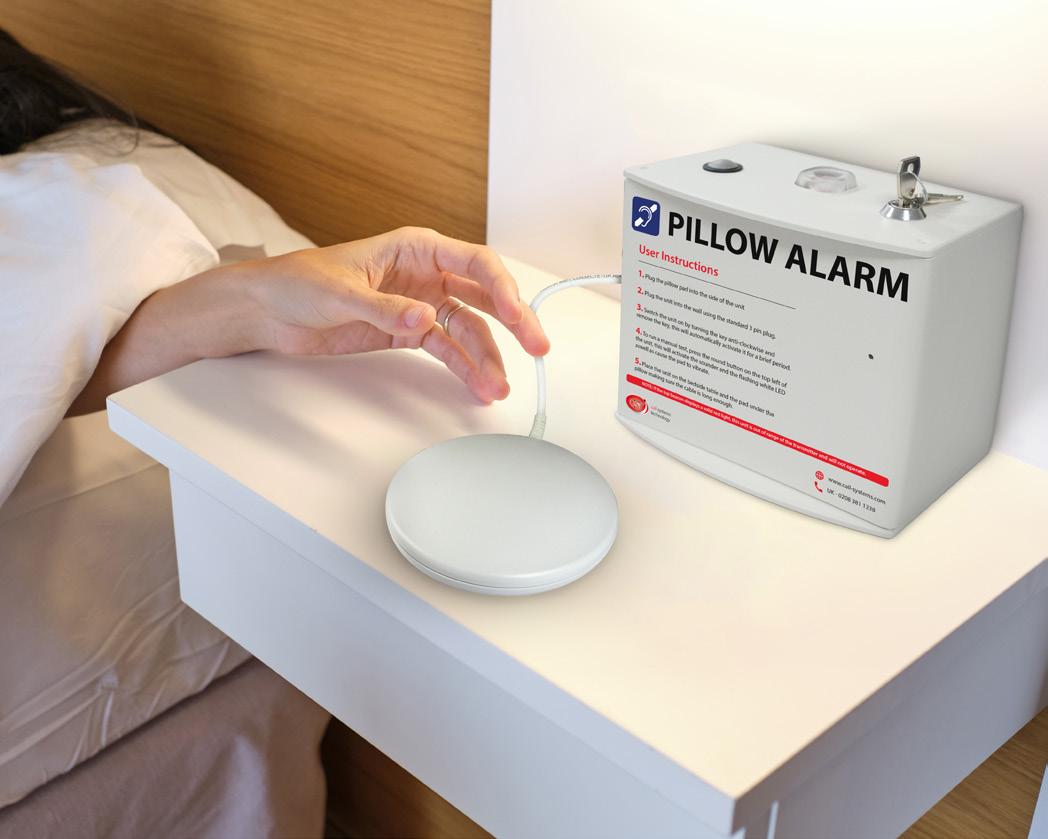
Gen2 Queue is a standalone wireless fire alarm system capable of harvesting messages, offering addressable alerts, and supporting multiple buildings. Additionally, it is not reliant on any other 3rd Party Networks like LAN, WAN, GSM.








Completely Wireless and Fully Monitored
AlarmCall Pro + Interface Transmitters Designed to Meet BS5839-1 & En54-4 Standards
Fully Addressable Alarm Activations
General Faults and Critical Fault Notifications
Full Reporting Suite
Escalations to ARC, Pagers, Smart Mobiles and Two-way Radios

Jamie Gale, technical officer at the Fire Industry Association, outlines the responsibilities placed upon premises management in maintaining, overseeing and ensuring compliance of fire detection and alarm systems
The management of fire detection and fire alarm systems within non-domestic premises is a crucial responsibility.
BS 5839-1 is the Code of Practice for the design, installation, commissioning and maintenance of fire detection and fire alarm systems in non-domestic premises. The current revision dates back to 2017, however a new revision is due to be published mid to late 2024.
Compliance with the recommendations detailed in this standard is vital for the safety of persons within buildings, ensuring they have suitable and sufficient warning of fire, and also for protection of property.
This article aims to outline the responsibilities placed upon premises management in maintaining, overseeing, and ensuring
compliance of their fire detection and fire alarm systems.
The first point to note is that there needs to be a designated person appointed as the Named Premises Manager. This individual holds the pivotal role of supervising all matters pertaining the fire detection and fire alarm system within their premises. The role of this person is to ensure that the system is tested and maintained in accordance with the recommendations of BS 5839-1, that appropriate and suitable records are kept, and also, that relevant occupants in the protected premises are aware of their roles and responsibilities in connection with the fire detection and fire alarm system. E

Attend our sustainability seminar at the Fire Safety Event 2024!
Join Vicki Wells, Sustainability Expert for Apollo Fire Detectors Ltd. at the Fire Safety Event on Wednesday 1 May, where she will present on how sustainability is reshaping the fire industry. Find out more about carbon and environmental management, responsible companies in supply chains and more. Learn more about the seminar here: www.firesafetyevent.com/seminars

Presenter: Vicki Wells, Sustainability Manager
Time: 13:10–13:40 pm
Date: Wednesday 1 May 2024
Location: Innovation & Compliance Theatre
Fire and Safety Event 2024
30 April – 2 May 2024
National Exhibition Centre (NEC) Birmingham B40 1NT

MEET US AT THE SHOW!
SCAN THE QR CODE TO SAY HELLO...

F This person also needs to ensure that necessary steps are taken to avoid situations that are detrimental to the standard of protection afforded by the fire detection and fire alarm system and to ensure that the level of false alarms is minimised.
One of the primary responsibilities of the Named Premises Manager is to arrange a service and maintenance agreement with a provider. Prior to selecting a suitable servicing and maintaining organisation, it would be beneficial for the Named Premises Manager to carry out due diligence checks concerning the credentials of any potential incumbent company. Companies and their technicians should be competent to carry out the tasks they are being contracted for.
As per BS 5839-1:2017, the definition of a competent person is a person with the relevant current training and experience, with access to requisite tools, equipment, and information, and be capable of carrying out a defined task.
In order to become an FIA member company, stringent criteria must be met, one of which is third party certification. All FIA member companies are third party certified, giving peace of mind when choosing providers of fire and life safety services. In short, ThirdParty Certification is, in essence, a consumer
protection scheme. It provides those certified companies, the opportunity to further prove that their company is competent. In order to maintain their Third-Party Certification, each company is assessed on an annual basis by way of an independent audit by a UKAS-accredited certification body, who verify that the company continues to meet specific British Standards and best practices from a business management perspective.
The FIA would always promote the use of a Third-party certified company.
On the appointment of a servicing and maintaining organisation, open channels of communication between the Named Premises Manager and the service provider are crucial. This will assist with the effective exchange of information such as dates, times and types of all tests, faults, false alarms, and defects, which should be meticulously documented within the system logbook, ensuring a comprehensive oversight of the system and its performance.
Maintaining an effective system
Routine checks of the system and the environment are important to maintain effective system functionality. The fire alarm panel (Control and Indicating Equipment (CIE)) should be inspected at least once every 24 hours to ensure the system remains fault free. E

F In the event of faults being indicated on the CIE, the inspection and servicing company should be informed, and in order to comply with BS 5839-1, a technician should attend the premises within an eighthour window of contact being made.
In addition to checking the CIE, the Named Premises Manager (or a suitably trained representative acting on their behalf) should also ensure that physical obstructions around detectors and call points are avoided, thereby ensuring a minimum clear space around detectors of 500mm and continued conspicuous positioning of manual call points.
Weekly testing is a vital aspect of continued system maintenance, confirming that the system control and indicating equipment is capable of processing a fire alarm signal, whilst providing an output to the fire alarm sounders. It also serves as an opportunity to check for correct transmission of signals to an alarm receiving centre (ARC) if monitoring is installed, and also ensures that personnel within the building remain familiar with the fire alarm signal.
The Named Premises Manager or other designated personnel such as a fire marshal, or a technician from the service provider, should perform weekly tests using a different manual call point each time, ensuring that all
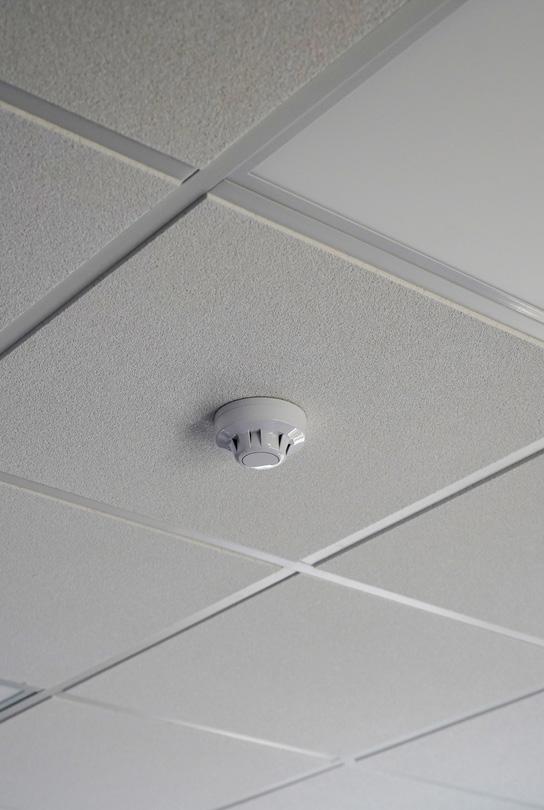

manual call points are tested over a prolonged period. Often, Premises Managers are known to misinterpret this, mistakenly believing that they should test all manual call points within a 12month period. However, there is no maximum timeframe for this process. For instance, a system with 100 manual call points would take 100 weeks to complete weekly testing of each device. This minimum recommendation of a single call point test per week does not preclude the testing of more than one.
The test should be carried out at approximately the same time each week, and any personnel in the premises at the time of testing should be aware of this and report any instances of poor audibility to premises management. On completion of the test, an entry should be made into the system logbook recording the date, time, and device used to initiate the test.
Where applicable, monthly repetition of the weekly test helps acquaint occupants working outside regular hours with the fire alarm signal. In cases where an automatically started standby generator forms part of the system’s power supply, compliance with manufacturer instructions for testing becomes essential. Testing should include running the generator on load for a minimum of one hour, followed by checks and replenishment of fuel, oil, and coolant levels as required.

It should be ensured that changes to the building(s) do not compromise the efficacy of the system. Any alterations, such as installing partition walls, must not impede audibility of alarms or obstruct smoke/heat movement towards detectors, maintaining the system’s effectiveness in detecting and signalling fires.
Where a room has undergone a change of use, premises management should also ensure they consider the ongoing suitability of any detection installed for the avoidance of potential false alarms, and following the changes, whether the level of detection remains sufficient. Consultation with their incumbent service provider might be necessary for further advice and guidance. Documentation also plays a vital role in ongoing system maintenance.
Records including system drawings, specifications, user instructions, maintenance guidelines, handover certificates, inspection and servicing certificates, and fire risk assessments should be meticulously stored and maintained by premises management, whilst remaining easily accessible to the inspection and servicing contractor, regulatory bodies, insurers, and any other interested parties.
They should also be updated throughout the life of the fire detection and fire alarm system
where necessary. Having this documentation, ensuring it remains current, and utilising it correctly, can also prove invaluable as evidence of compliance with fire safety legislation such as the Regulatory Reform (fire safety) Order 2005.
The need for guidance Premises management are only able to carry out the duties and responsibilities placed on them after receiving sufficient instruction and guidance. This should take place as part of the handover of any completed system, where all relevant individuals should receive comprehensive instruction on using the system effectively. This instruction should also include understanding fire alarm, prealarm and fault signals, operating controls associated with initiating alarms, silencing alarms, and resetting the system.
Compliance with these responsibilities is not just a regulatory necessity but pivotal in ensuring the effective and reliable operation of fire detection and alarm systems within non-domestic premises. The meticulous execution of these tasks serves to safeguard lives and protect property. L
Further information and details of training courses can be found on the FIA website www.fia.uk.com

The Health & Safety Event will be hosted at the NEC Birmingham once again to showcase the best and brightest professionals and products occupational health and safety
Health and safety professionals will be able to network in-person with their peers at the event on 30 April-2 May. They can also share best practice and explore the latest innovations and trends in the sector. Hosting over 300 exhibitors, delegates have the opportunity meet directly with experts to compare thousands of the latest products and solutions for their health and safety management.
At the event, there will be over 10,000 products and solutions relating to health and safety management in the workplace. Hosting many major players from the industry including MSA, Dräger, Barbour, JSP limited, Portwest, U-Power, and UVEX among others, delegates
will be able to speak to the experts directly to discuss any upcoming projects.
Returning to the Health & Safety Event, Start-Up Street is a dedicated area for startups to exhibit. They will be showcasing their cutting-edge products and solutions that are shaping the future of risk management and saving lives.
Over 10,000 products and solutions will be showcased at the event including asbestos control, confined space, drug & alcohol testing, driver safety, emergency equipment and waste management.
Information on fall arrest and prevention, Gas Detection, Hazardous Material Storage and Handling will also be available.
IOSH, Health & Safety Executive, BSIF, UKATA, Highways England, SAFed, SHEP and many more industry bodies and associations have confirmed their attendance. Speak directly to the industry experts, sharing knowledge and insight to ensure you are up to date with industry standards and best practice.
Visitors come from every level of the buying chain and are from a diverse range of industries. Some of the confirmed visitors include: BT, Holland & Barrett, Dominos, Amazon, National Grid, Rolls Royce, Centurion, GXO, The Gym, Virgin Media O2 and more.
To meet the business needs of health and safety professionals, CONNECT+ Live will return for another fantastic year of specialised networking. Matching the visitor’s buying requirements and needs with carefully curated exhibitors, the CONNECT+ Live team of matchmaking experts will fast-track access to key suppliers.
Back by popular demand, complimentary networking drinks will take place at the end of each day. Taking place at the Networking Café, this is the perfect opportunity to unwind and meet industry peers and professionals.

Specialist features and zones Exciting features include the Registered Safety Supplier Trail in partnership with The British Safety Industry Federation (BSIF). All suppliers of this trail have signed a binding declaration to ensure they meet the appropriate standards, fully comply with the PPE regulations and are appropriately marked.
In partnership with Highways England and Driving for Better Business, this is part of the dedicated feature - The Driver Safety Zone. This zone will share vital information and resources with safety professionals who have responsibility for work-related road risk.
The Health & Safety Event will boast CPDaccredited content across five theatres across the three days. Attendees will receive comprehensive and up-to-date information on the most critical aspects of health and safety.
The Keynote Theatre is the main stage at The Health & Safety Event, supported by IOSH. This theatre will welcome key industry speakers who will be providing the latest news and updates as well as regulations, guidance, and training within the health and safety industry.
The Practical Safety Theatre, sponsored by Milwaukee, will also be in attendance. Hear from the experts on how to create a safe and compliant working environment. Gain the practical tools and knowledge to protect you and your employees from danger.
The Knowledge Exchange supported by HSM will return and will feature a series of sessions covering the challenges faced by health and safety professionals and practitioners. Get the low down from industry experts who are making a difference in the workplace and safety culture.
The Driver Safety Theatre, in partnership with Driving for Better Business and National Highways is part of the Driver Safety Zone, will share a series of presentations and panel discussions covering legislation updates, driver fatigue, distraction, staff culture, vehicle safety and much more.
Lone Worker Safety Live will share their knowledge to showcase the best ways to manage the key issues of wellbeing, safety, and security for lone and remote workers. L
FURTHER INFORMATION
www.healthandsafetyevent.com





Using a layered security approach will help education settings delay, deter and prevent incidents. But as part of this strategy, it is key to balance security without imposing fear, as Reilly Russell explains
Every place of education has a duty of care to its staff and students. With this, comes with the responsibility of ensuring their safety is being taken care of from a security perspective. It is also a legal obligation under the Health & Safety Act 1974 that defines how a school, college or university is liable to protect the wellbeing of those on the premises. However, this can be challenging with the wide variety of threats that places of education face. Despite this, it is easily managed and maintained with the best security practices in place that will help minimise threats as much as possible.
Putting in place a layered security approach to a school can help mitigate risks at their point
of potential. This means putting in several security measures that aim to tackle different threats. For example, start by looking at the perimeter of a place of higher education. Think about it: Is it fenced off with limited access, or is it open to the public to walk into? If not adequately protected, the risk of trespassing will significantly increase. With trespassing also comes the risk of vandalism, burglaries, and other unwanted incidents. Some sixth forms and colleges overcome this with the use of physical security that surrounds the entrance point of the premises, such as external speed gates. Of course, this sort of solution needs to withstand the harshest of weather conditions to remain outdoors. Therefore, speed gates with an IP53 rating will overcome this. Meesons’ E

F EasyGate SPT-Outdoor Speed Gates have IP53 Rated Ingress protection, meaning they can cope with heat and humidity as well as rain and snow. It is also crucial for these solutions to be unobtrusive to avoid causing a concern.
Additionally, to protect both the perimeter and infrastructure, good quality CCTV can be introduced. Cameras will work as a subtle visual deterrent while also helping management identify who is responsible for any problems caused. If the sixth form or college poses a high risk, then the addition of sensor-activated CCTV may be necessary. Alongside sensor detection, to enhance perimeter protection further, ANPR CCTV will pick up cars’ number plates; therefore, if there is suspicious activity going on around the premises, it can be picked up on and investigated. Within the infrastructure of sixth forms and colleges, access control plays a pivotal role for its security. For example, access control can prevent students from entering staffonly areas with key fob or smartphone access tools. By doing this, a visitor management system can be implemented and restricting access to certain areas within the building can be enforced. The benefit of this is also that if a burglary or vandalism incident occurs, the visitor management system can inform you of who was in present at the time, helping you solve the problem far quicker.

Balancing security without imposing fear
As part of this layered approach to a place of education’s security, it is key to balance the measures in place without imposing fear. This means using solutions that easily blend into the surroundings and are unobtrusive. When selecting solutions such as speed gates, it would be best practice to customise them to suit their surroundings. For example, when Meesons provided outdoor speed gates to Halesowen College, the college chose stainless steel as it suited the industrial appearance. However, a larger, more heavy-duty security solution that won’t go unnoticed may alarm students as to why such strict security measures are in place and, therefore, cause worry or a sense of uncertainty. In comparison to this, speed gates are subtle and can match the aesthetics of the environment while still working as a visual deterrent to people who may want to gain unauthorised access.
Likewise, CCTV can be carefully placed to deter people who are causing problems and looking out for security measures, but without making students and staff feel as though they’re being watched. However, it is important that they can be noticed as it will prevent those

As part of this layered approach to a place of education’s security, it is key to balance the measures in place without imposing fear
looking to vandal or steal from doing so due to the consequences of being caught. On top of this, key fob entry is a subtle security measure that is user-friendly and gives a sense of safety without being very noticeable. Smartphone entry enhances this security further as it will prevent students from entering using incorrect credentials while being unlikely to misplace this form of entry in comparison to a key fob. In addition, having such access control methods in place allows an accurate generation of data about building activity which can help a place of education in future determine the busier areas to add additional security layers to.
Prevention is key Prevention is key to ensuring a place of education is carrying out the best security measures. Having a response plan in place in case of an incident will be ideal for dealing with it quickly and efficiently. Also, gathering feedback from staff and students can help places of higher education improve the security measures in place. For example, having a security union at a college that contributes ideas, expresses personal pain points regarding safety concerns, and voices feedback from others can help to tackle the exact issues that the particular place of education is facing. Finally, having a strict security policy in place that is adhered to will ensure that you have the right contacts for any problems that occur with the security systems or local police contacts for emergencies, as well as how to handle the risks if they happen.
Conclusion
Combining this mix of security layers will help colleges and sixth forms achieve security best practices. Using a layered approach strategy allows all methods to work together to delay, deter, and prevent incidents. Having these measures in place will ensure that staff and students feel safe and protected and help overcome incidents if they occur. L
Written by Reilly Russell from Meesons, on behalf of the British Security Industry Association (BSIA).
If you’re juggling your kitchen extract and ventilation cleaning along with fire damper testing, Legionella management and IAQ testing, talk to us about our packaged services, which save you time and money.
Cleaning and high hygiene standards are important in education settings to ensure a healthy environment for pupils and staff. We outline the latest updated guidance from the government
Maintaining good hygiene standards in schools can make a big difference in containing the spread of infections for staff and students.
During the pandemic, we were more than aware of using the hand sanitiser after every touch of the keyboard and the constant cleaning of door handles. Now that the peak of Covid-19 has thankfully passed, preventing and controlling infection is still important.
The government advises a “proactive and preventive” approach to controlling these infections, including the promotion of available immunisations.
There are a variety of ways you can keep on top of hygiene in education settings, and the government has updated its guidance to reflect the latest health recommendations.
Let’s start with hand hygiene
It seems like a given, but make sure everyone has access to liquid soap, warm water, and paper towels. Bar soap should not be used. Alcohol hand gel can be used if hands are not visibly dirty, but
is not effective against organisms that cause gastroenteritis like norovirus.
Pupils and staff should be told to wash their hands thoroughly for 20 seconds with running water and soap and dry them thoroughly, or use alcohol hand rub/sanitiser ensuring that all parts of the hands are covered.
Now we come to respiratory and cough hygiene. The ‘catch it, bin it, kill it’ approach to respiratory hygiene we are all-toofamiliar with from the pandemic must be communicated to pupils and staff.
This involves covering your mouth and nose with disposable tissues when you cough or sneeze. If one is not available, sneeze into the crook of your elbow, not into your hand. Dispose of tissues into a disposable rubbish bag and immediately clean your hands with soap and water or use a hand sanitiser. Everyone should also be encouraged to follow other hygiene etiquette like keeping contaminated hands away from their eyes, mouth and nose, as well as washing hands after touching contaminated objects and materials. E
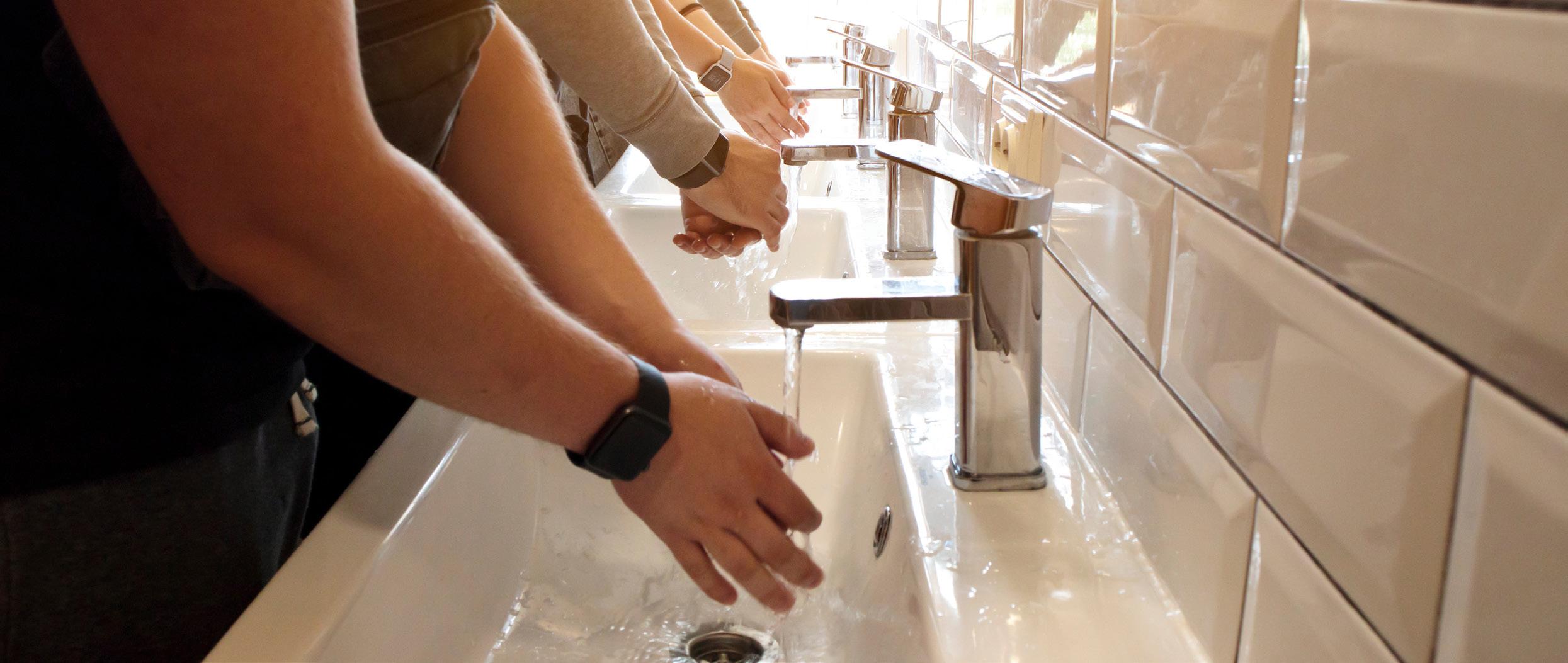

In terms of cleaning, the government said that keeping settings clean, including equipment, reduces the risk of transmission of infections and viruses. This involves frequent cleaning of rooms or shared areas that are used by different

groups, as well as frequently cleaning touched surfaces, such as door handles, handrails, play equipment, toys, and electronic devices. Schools should also ensure that all areas or surfaces in contact with food, dirt, or bodily fluids are regularly cleaned and disinfected. Cleaning with detergent and water is normally all that is needed as it removes most germs that can cause diseases. Making a periodic cleaning schedule is also advised by the government.
If there is an outbreak of infection at your setting, your UKHSA health protection team (HPT) may recommend enhanced or more frequent cleaning, to help reduce transmission.
In cleaning schedules, clearly describe the activities required, the frequency of cleaning and who will carry them out.
Develop plans for situations where additional cleaning will be required (for example in the event of an outbreak) and how the setting might carry this out.
Ensure cleaning staff are appropriately trained and have access to the appropriate personal protective equipment (PPE), such as household gloves and aprons.
Although there is no legislative requirement to use a colour-coding system, it is good practice. Use colour-coded equipment in different areas with separate equipment for kitchen, toilet, classroom, and office areas (for example, red for toilets and washrooms; yellow for hand wash basins and sinks; blue for general areas and green for kitchens).

Cleaning equipment used should be disposable or, if reusable, disinfected after each use. Nominate a member of staff to monitor cleaning standards and have a system in place for staff to report issues with cleaning standards and discuss any issues with cleaning staff, or contractors employed by the setting.
The same concept applies to spaces where food is handled or prepared. The Food Standards Agency advises using a dishwasher, sterilising sink, or a steam cleaner and disinfect equipment and utensils.
In bathrooms, frequently touched surfaces should be cleaned regularly. Ensure suitable hand washing facilities are available including running water, liquid soap and paper towels or hand dryers. Where cloth towels are used, these should be for individual use and laundered in accordance with washing instructions.
Place disposable paper towels next to basins in wall-mounted dispensers, together with a nearby foot-operated wastepaper bin.
Make sure toilet paper is available in each cubicle (it is not acceptable for toilet paper to be given out on request). If settings experience problems with over-use, they could consider installing paper dispensers to manage this.
Personal protective equipment (PPE) is advised in certain situations as it can protect you from contamination with blood or bodily fluids that could spread disease.
It is advised to frequently clean touched surfaces, such as door handles, handrails, play equipment, toys, and electronic devices
If there is a risk of splashing or contamination with blood or bodily fluids during an activity, wear disposable gloves and plastic aprons. Gloves and aprons should be singleuse disposable, non-powdered vinyl/ nitrile or latex-free and CE marked.
Wear a fluid-repellent surgical facemask and eye protection if there is a risk of splashing with blood or body fluids to the face. If reusable, decontaminate prior to next use.
If a risk assessment of the setting indicates that a higher level of virus may be present such as when someone unwell has spent the night (such as a boarding school dormitory) then additional PPE to protect the cleaner’s eyes, mouth and nose may be necessary.
Ventilation is the process of introducing fresh air into indoor spaces while removing stale air. Letting fresh air into indoor spaces can help dilute air that contains viral particles and reduce the spread of COVID19 and other respiratory infections.
The Department for Education introduced state-funded education and childcare settings with access to CO2 monitors to help them assess how well ventilated their spaces were during the pandemic.
These monitors are portable, enabling settings to move them around to assess ventilation across their full estate, starting with areas they suspect may be poorly ventilated.
Other ways to improve ventilation include opening windows and doors as much as possible to let fresh air in, opening higher-level windows to reduce draughts, where it is safe to do so.
If you have CO2 monitors, use them to balance the need for increased ventilation with maintaining a comfortable temperature. During the colder months, you may consider opening windows more when the room is unoccupied in between lessons. L
Read the guidance here.


Peninsula protects employers across the globe with employment law, HR, and health & safety services. From small start-ups to well-known brands, we support tens of thousands of businesses with HR and health & safety. Business owners reduce their legal risk and save time with our expert advice, documentation, and more.
www.peninsulagrouplimited.com

Diversity in the workplace is intrinsic to creating a more equal and happy environment. But what can be done by school leaders to make this the norm? Robyn Quick investigates
Nobody wants to feel isolated at work, and the education sector is no exception. Just under a third of LGBTQ+ employees in education have experienced bullying because of their identity, according to a survey conducted by the National Education Union in 2022. This is a troubling statistic, especially considering that there are an estimated 50,000 LGBTQ+ teachers in UK schools. To make matters worse, there are almost no
openly LGBTQ+ headteachers or senior leaders. Many workers in education are keen to make the workplace more inclusive to members of the LGBTQ+ community, and to encourage progression for everyone regardless of their identity.
Having a diverse workforce in education is not just positive for staff, but is also a good influence on students both at primary and secondary levels. According to Social E

F Development Direct, when LGBTQ+ adolescents are not given the space to ask questions about different sexualities they are put at increased risk of exploitation by predatory individuals.
Some steps have been made in the area of educating students on LGBTQ+ relationships, but there is still a long way to go. Section 28, a series of laws introduced by Thatcher in the ‘80s to prohibit “the promotion of homosexuality” in schools, was only scrapped in 2000. It meant LGBTQ+ teachers were forced to stay in the closet and avoid helping students who were struggling with their sexuality or gender. More than 20 years on, some say the repercussions of this rule can still be felt.
In positive news, statutory relationships, sex and health education (RSHE) means all children and young people can get the information they need to make informed choices. In 2020, relationship education for primary school age pupils and health education for all pupils in state-funded schools was made compulsory. While it was celebrated by both allies and LGBTQ+ people, there was some pushback against teaching pupils about different family structures.
When announcing the decision, former education secretary Damin Hinds said: “At the
heart of preparing children for life in modern Britain is making sure that they understand the world they are growing up in. It is a world that is different from 20 years ago, when this guidance was last updated, and this is a significant step that will help young people to look after themselves and each other.”
This statement is particularly pertinent to encouraging members of the LGBTQ+ community to join the education workforce, as it should be equally welcoming to LGBTQ+ staff as it is to students.
So, what can be done to make education settings more appealing for LGBTQ+ employees? We have gathered some topnotch advice for best practice from The Chartered College of Teaching, as well as hearing from educators who are dedicated to making their workplace LGBTQ+ friendly.
Embed an inclusive culture
Making people feel like part of a community is crucial to continued employee satisfaction, and ultimately means they will feel safer in the workplace.
Whether this involves organising workshops with charities like Stonewall or being supportive if a colleague ‘comes out’ to

other staff, there are many ways to embed an inclusive culture into individual workplaces.
The Chartered College of Teaching is one organisation that provides advice for education workplaces to be more inclusive to employees. They are a body of teachers who are dedicated to celebrating, connecting and supporting educators.
Katy Chedzey, head of professional learning and accreditation at the Chartered College of Teaching, said: “We know that having a diverse and inclusive staff team can bring a range of benefits to schools, including impacting on student attainment, improving mental health for students and staff, and improving teacher retention.”
She said that where a staff body is not as diverse or representative as it could be, “there’s an opportunity for schools to critically review practice and identify any barriers or opportunities for improvement.”
For Chedzey, a starting point for this is to review recruitment practices. To take this a step further, however, schools can commit “to the ongoing review of all aspects of school policy and practice [...] by actively working to support progression of staff from underrepresented groups into more senior positions.”
Having a diverse workforce in education is not just positive for staff, but is also a good influence on students both at primary and secondary levels
These themes are explored further in the Chartered College of Teaching’s online module on ‘Building and Developing an inclusive staff team,’ part of their Leading Inclusive Schools series.
Bennie Kara, former deputy headteacher and author of ‘A Little Guide for Teachers: Diversity in Schools’ said in a piece for the Chartered College of Teaching that “schools can protect LGBTQ+ [teachers] through policy and practice.” She said this can be done in a variety of ways.
For example, individual schools can ensure the policy for adoption leave looks the same for same-sex couples as it does for oppositesex couples. She said: “Is it just the LGBTQ+ staff running Pride Clubs and wearing rainbow lanyards or does everyone do it E


F to show their support for LGBTQ+ rights?
Is there a policy that states that all teachers should challenge homophobia?”
Asking these kinds of questions regularly ensures that your school’s policy is up to date, as well as showing support for LGBTQ+ people in the workplace.
LGBTQ+ teachers can attend workshops, conferences and seminars run by groups like NASUWT where some specialise in LGBTQ+ issues.
Finally, it is important for LGBTQ+ educators to be able to see themselves reflected in senior roles as well as more junior ones.
One of the biggest reasons LGBTQ+ teachers are not out at work is that they are worried

One of the biggest reasons LGBTQ+ teachers are not out at work is that they are worried it will have an impact on the progression of their career. Therefore, school leaders must be sure to show that opening up about one’s identity will not limit their career options
it will have an impact on the progression of their career. Therefore, school leaders must be sure to show that opening up about one’s identity will not limit their career options.
This can be done by having visible LGBTQ+ role models in management positions, for example. Of course, this kind of progression is much harder than running a workshop. Change like this will come slowly, but it can be done.
Education has come so far since the atrocity of Section 28, with a variety of different organisations pushing for change and championing LGBTQ+ people in education.
Looking to the future, NEU survey creator Joseph Hall said: “A whole school approach to inclusion needs to cover the curriculum – all year round – and making sure negative attitudes and language [from students and teachers] is properly challenged on an ongoing basis.” L
Effective outdoor play environments can significantly impact children’s development, helping them to flourish and grow alongside their classroom learning. Pentagon Play explains how to achieve this
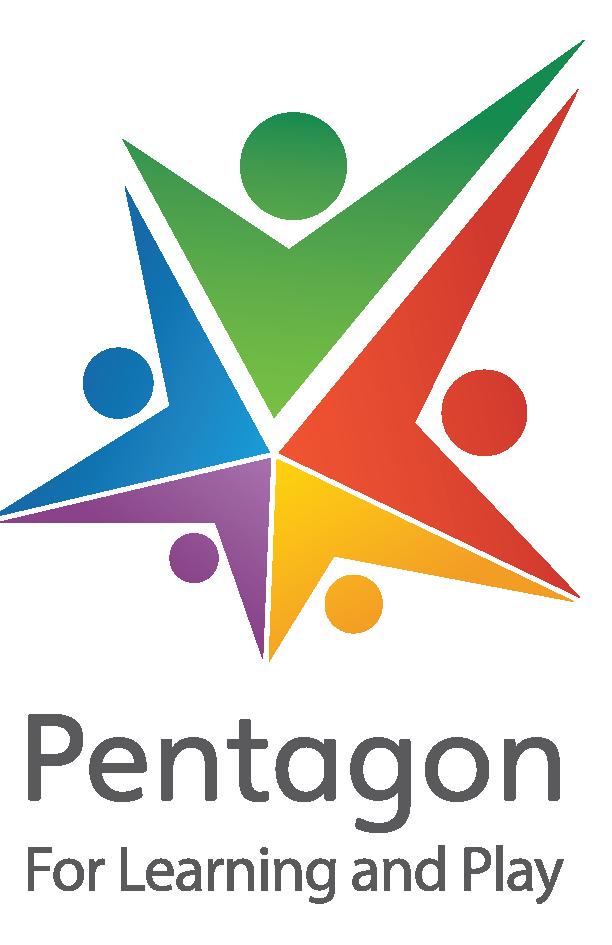
Quality outdoor play spaces are designed to encourage relationships, foster communication, and witness collaboration through play. Children need space both indoors and outdoors where they can be active or quiet, where natural or purchased resources should be accessible, wellorganised, refreshed when needed and where children can make independent choices.
Outdoor environments can be arranged into distinct activity zones including calm areas and spaces for sensory play. A variety of learning and play zones in your playground will ensure that children have the opportunity to access different areas of their development.
Here are just some of the fantastic areas that you could create in your outdoor space:
Role play allows children to mirror images from daily life, exploring their ideas about the world in a safe space. Pupils build crucial skills in communication, problem solving and emotional awareness. Create an ideal role play zone with plenty of space and storage for
items like cooking utensils, food packaging, and a range of multicultural fabrics and dressing- up clothes. This creates a versatile play space for children with differing interests.
Sand and water play can be deeply engaging areas of the Early Years Foundation Stage (EYFS) classroom. A sand area should be accessible for children to use with resources readily available and clearly labelled. Playing and digging helps to develop shoulder stability, wrist control and grip strength needed for writing and drawing. Water play can take on many different forms, promoting curiosity and observation. Water temperature can be explored and different scents can be added to water, perhaps adding fruit pieces.
The addition of a music or performance zone brings pleasure, joy and opportunities for creative expression. Music and drama activities allow children to express their emotions and provides opportunities for personal and social development.
In this area children may enjoy listening to music and sounds. They can be given opportunity to experiment with a range of different instruments from different cultures by selecting e.g., chime bars, bells, rainmakers, maracas and guitars from baskets or shelves.
If planned well an effective outdoor play space gives children freedom to explore, discover and create for themselves allowing practitioners to observe, challenge and lead children to deeper understanding. M
INFORMATION
www.pentagonplay.co.uk
Rupert Weber, head of education at apetito, explores the importance of lunch in supporting students’ learning

It is well known that a nutritious lunch is critical to students’ health and wellbeing. The World Health Organisation says schools should prioritise providing healthy food, as it has a positive impact on academic performance1 . And you only need to spend time with a child who is hungry to see how important it is for them to stay well-fuelled so they can grow, develop, and learn.
At apetito, we do the heavy lifting for schools. Our range of over 200 premium pre-prepared meals and desserts mean there are nutritious options that suit every taste and dietary requirement. In fact, one of our favourite phrases is ‘eat well, learn well’. Our nutritionists and dietitians ensure all our dishes meet the delicate nutritional requirements for children, so schools can provide pupils with high-quality meals packed full of nutrients that give students the energy they need to focus in lessons.
But we go one step further. With support from our chefs, dietitians and nutritionists, our dedicated account managers support schools with menu planning to ensure they are serving the right meals that provide pupils with the fuel they need to learn.
Time and time again, we see improvements in students’ behaviour, concentration and learning when our healthy food, packed with vital nutrients, is introduced. But don’t take it just from us.
Headteacher of Ropemakers Academy, Simon Hawthorne has noticed a real impact since partnering with apetito.
He said: “Since we’ve introduced apetito, there has been a significant improvement in the quality of the food we’re serving and this in turn has had a real impact on the children.”
Hawthorne added: “The better the food, the happier we find our pupils are and we’ve noticed a lot more positive behaviour since partnering with apetito. The children eat well and, in turn feel well.”
“With apetito,” he explained, “we’re able to have more control over what we’re serving because we’re the ones planning the menu. This means we have a lot more flexibility and control than we would have with a contract caterer.”
“For so many of our children, food is such an important part of their life and by working with apetito, we know able to serve them highquality, nutritious meals that they really enjoy.”
With apetito, it costs schools less to deliver our premium pre-prepared meals, which provide consistency of cost and can be cooked with 50 per cent less staff, removing the impact of rising food and labour costs, and giving schools more money to put into frontline education. M
References
1. WHO. Food and Nutrition Policy for Schools: A Tool for the Development of School Nutrition Programmes in the European Region. WHO Regional Office for Europe; Copenhagen, Denmark: 2006

Almost 80 per cent of education staff experienced mental health problems because of work last year. Robyn Quick examines what can be done about it
The mental health of teachers has only recently been put under the spotlight. The focus on students prospering and being mentally well is, of course, usually the top priority for parents and carers.
But the death of Ruth Perry, a headteacher at Caversham Primary School in Reading, meant the wellbeing of education workers is now being treated more seriously. In December 2023, 53-year-old Perry died by suicide. The coroner later ruled that the stress and emotional strain of awaiting the results of an Ofsted report of her school played a part in her death.
The coroner. Heidi Connor concluded her inquest by saying: “The evidence is clear in this respect, and I find that Ruth’s mental health deterioration and death was likely contributed to by the Ofsted inspection.”
Connor called for Ofsted officers to have clear guidance when it comes to noticing signs of distress in school leaders at the risk of causing further deaths.
Now, the emotional strain that so many teachers and school leaders face cannot be avoided. It is not just Ofsted reports that can exacerbate mental health problems. Factors such as low pay, maintaining a work life balance and pupil behaviour are just some of the reasons people in education can experience poor mental health both inside and outside the workplace.
Faye McGuinness, director of programmes at Education Support, said the findings from their Teacher Wellbeing Index required immediate action.
She said: “Everyone deserves to be healthy and safe at work. Especially those who guide and inspire the next generation. Yet our findings show stress, depression and anxiety all remain at an unsustainably high level among teachers and education staff.”
McGuinness added that “no one can do their best work if they are emotionally and physically depleted.” E


F The Index found that 78 per cent of UK school staff reportedly experienced mental health symptoms due to their work in the last academic year of 2022/2023.
These reports of poor mental health are not just limited to teachers already in their job. The National Foundation for Educational Research reported that around 12 per cent of early career teachers (those within the first five years of qualifying) left the profession between 2015-2020.
It can be hard to take meaningful steps to improve school leaders and teachers’ wellbeing in the workplace.
We have created a list of what can be done to improve the wellbeing of school staff. Some are big changes that will take longer to implement, and others can be put into practise immediately.
One of the ways education workplaces can reduce stress levels is to make sure there are dedicated spaces for employees to properly relax. After all, the NASUWT’s ‘Teachers in Mental Health in the UK’ survey found that the biggest concern for teachers in 2019 was their workload.
These spaces don’t just involve putting a lava lamp in the staff room. Some people call them ‘peace corners,’ and they are spaces that provide staff mindfulness and relaxation. Of course, this is dependent on what schools can afford and what staff would like to be included. However, even the small act of holding sessions on managing stress can make
A way you can show appreciation to colleagues if you are in a more senior position is to declare your support via the education staff wellbeing charter
staff feel understood as well as giving them that much-needed platform to de-stress.
This is a better alternative to including ‘wellbeing days’ into the INSET timetable. These days have been criticised by education leaders and teachers for oversimplifying the constant journey of maintaining good mental health. As well as this, every one’s mental health is different so there will not be one day which will help everyone.
Remember that these spaces are not an easy fix to mental health, and should be included in a wider strategy.
It may sound obvious, but truly appreciating the hard work of those around you is essential to creating a supportive work environment.
Teacher Victoria Hewett wrote for Education Support that leaders should “find ways for staff to shout about the great things they’ve seen going on or are doing themselves and take the time to acknowledge them,” adding that “It doesn’t need to be a grand gesture but noticing and appreciating the small parts that make up the big picture is invaluable.” E



F This helps teachers and school leaders to know they are doing a good job, and feel they are making a difference.
Another way you can show appreciation to colleagues if you are in a more senior position is to declare your support via the education staff wellbeing charter.

For many teachers, one of the reasons they struggle with their mental health is the lack of a work-life balance. One way to combat this is to make flexible working available for staff
It was created by a variety of organisations like Mind and the Department for Education in a bid for all state funded schools to show a shared commitment to protect, promote and enhance the wellbeing of their staff. The charter is a tool for schools and colleges to create and publicly commit to their own wellbeing strategies, as well as creating a staff wellbeing strategy.
Signing up is voluntary, but it shows staff that you are dedicated to changing the workplace for the better.
For many teachers, one of the reasons they struggle with their mental health is the lack of a work-life balance. One way to combat this is to make flexible working available for staff. This means making arrangements which allow employees to vary the amount, timing, or location of their work.
A flexible role can be important for those returning to teaching, especially following a caring-related break which may have been due to stress from work, although there are plenty of other reasons why someone might want to work flexibly.
Schools should also make sure there is clarity and fairness around implementing flexible work policies and processes. L
ECO GRIT
0800 193 6466
gaz@ecogrit.co.uk

ecogrit.co.uk
EcoGrit supplies a granular deicer which is safe to use around plants, children and animals. It is effective to below -20C and isn’t corrosive like rock salt. EcoGrit Concentrate is used by emergency services, wildlife trusts, English Heritage, National Trust, vets, councils and maintenance contractors to name just a few.
ASPECT SAFETY MIRRORS
01223 263555
info@aspectsafetymirrors.co.uk
www.aspectsafetymirrors.co.uk
ASM Ltd are the dance studio and gym mirror specialists. We are a family run business based in Cambridge, undertaking installations for dance and gym mirrors for schools, colleges and universities throughout the UK. Our products include, gym mirrors, dance mirrors with ballet barres incorporated if required and our portable mirrors, which are the ideal product when wall mirrors are not an option.
01252 551540
enquiries@adveco.co

https://adveco.co
For award-winning specialist design, supply, and service of sustainable water heating. Gain insight on systems with Live Metering to reduce carbon and mitigate cost of moving from gas to electric. Talk to Adveco about commercial heat pumps, solar thermal, water heaters, electric boilers, cylinders, packaged systems, and offsite constructed plant rooms.
©

